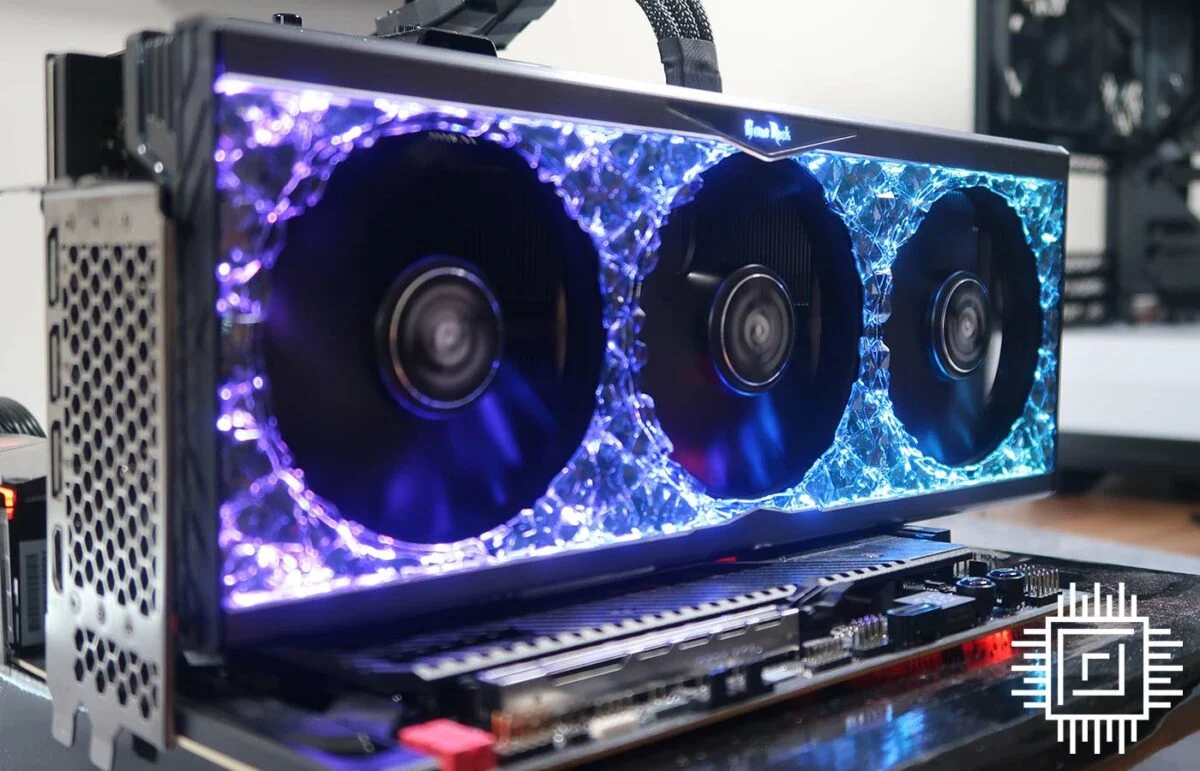
Nvidia has delivered a quick one-two in the fight for next-generation graphics supremacy. The clattering left-hook of GeForce RTX 4090 is followed swiftly by a stern jab in the form of RTX 4080, and though rival Radeons are hoping to disrupt proceedings in a couple of weeks’ time, the GeForce duo has set a high bar.
That’s good news for add-in-board partners craving new releases, though there is a rather large caveat in that the competing Founders Edition is now bigger and better than ever before. The days of custom designs being cooler and quieter than reference may be over, and it’s up to AIBs to find other ways to stand out in the crowd.
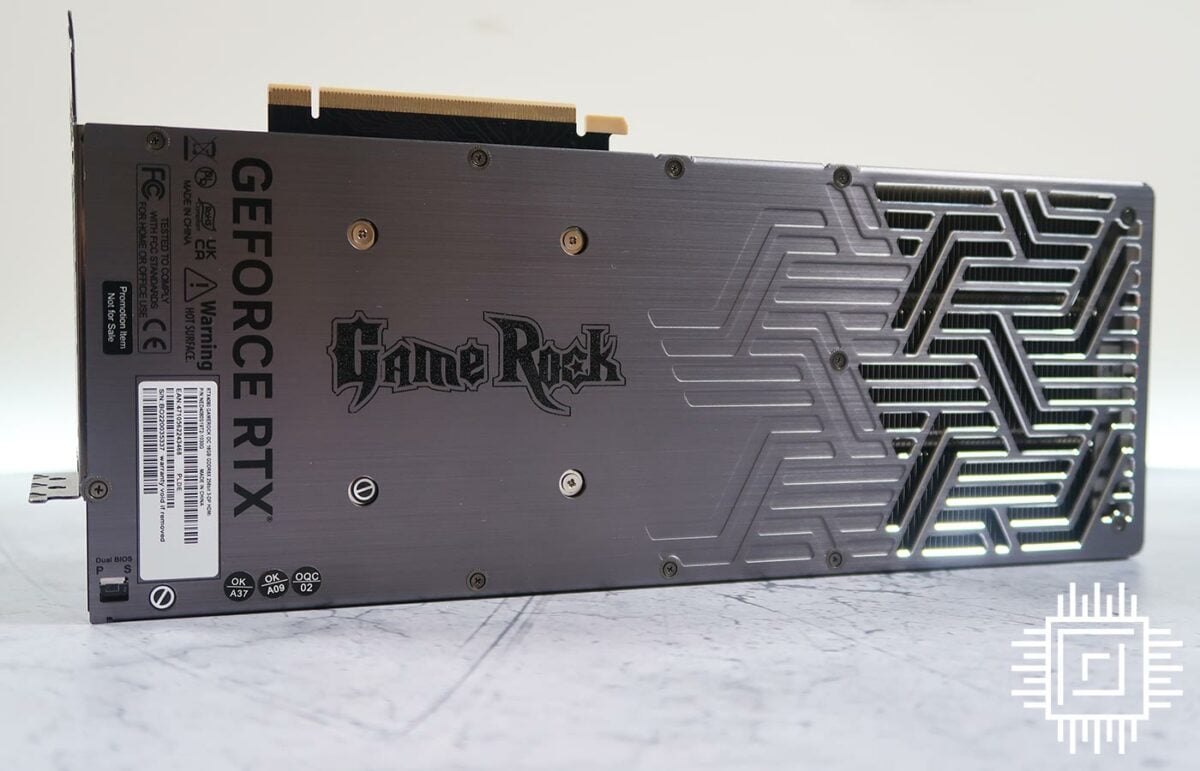
Palit, in our estimation, does a fine job by adding a whole heap of glamour while trying to keep prices relatively competitive. That latter point is a source of fierce debate. RTX 4080, at £1,269 for a Founders Edition, is already a frighteningly expensive prospect, and proof that second-rung 80 series has transitioned from merely high-end to truly extreme. Nvidia will claim the price point is justified – the in-house FE has unsurprisingly sold out – but plentiful stock of custom variants suggests partners face a tougher sell.
There are, believe it or not, some RTX 4080s priced at around the same level as RTX 4090 FE, which is nothing short of sheer lunacy. Nvidia’s flagship is a fundamentally superior GPU, and if you’re willing and able to spend over £1,600, RTX 4090 is the only way to go.
Appreciating this quandary, Palit arrives on the scene with three RTX 4080 models. The GameRock OmniBlack at £1,300, GameRock regular at £1,350, and GameRock OC at £1,400. Any uptick over reference is hard to stomach, yet Palit’s lineup represents some of the more affordable partner cards available, and with FE proving hard to come by, GameRock in particular offers something a little different to the norm.
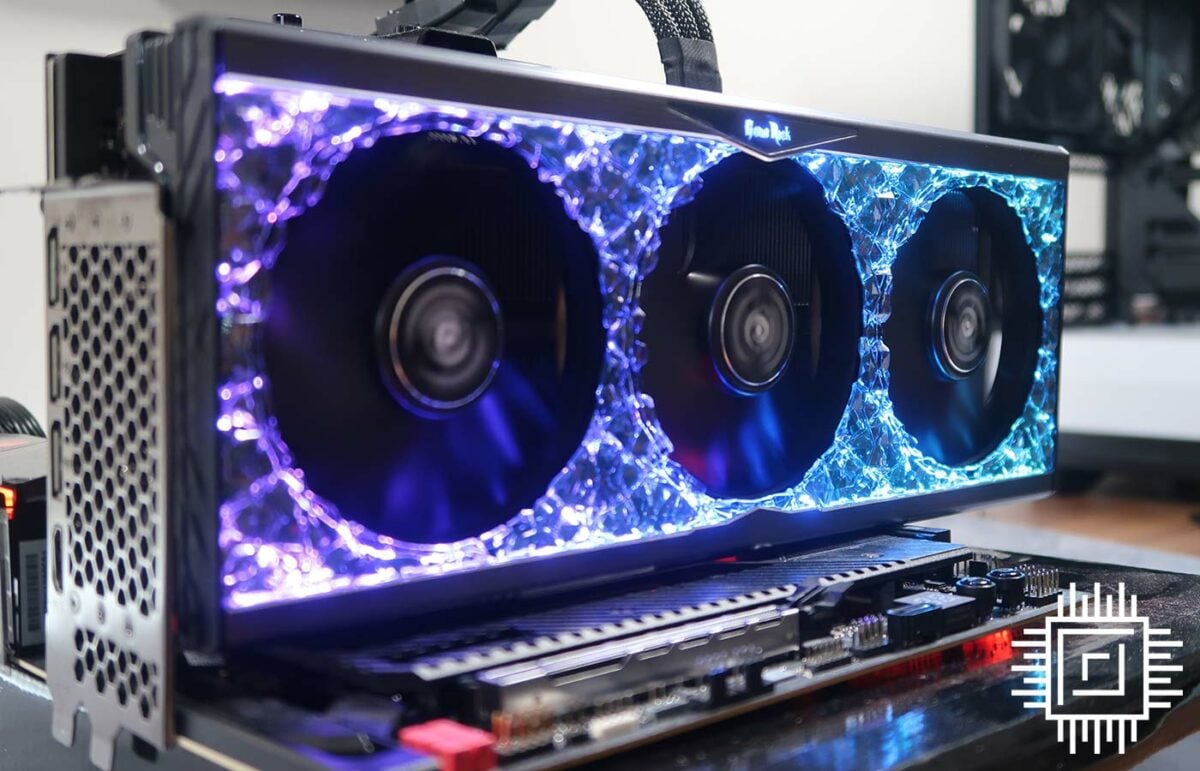
Key to the attraction is without doubt a ‘Midnight Kaleidoscope’ aesthetic that truly shines. Such an eye-catching design will always elicit a Marmite reaction, yet if you happen to deem the FE bland, GameRock OC is anything but. I love it; if you’re going to go for RGB, you may as well go all-in, and Palit’s card-encompassing glow puts most others to shame.
One proviso is the card really lends itself to a vertical orientation, and the kaleidoscopic effect is largely lost in a traditional horizontal installation. You do still get backlit GeForce RTX and GameRock branding across the top, and the underlying glow is unmistakable, yet it is the crystalline frontage that wants to be seen. Lighting colours and effects are controlled through Palit’s own ThunderMaster software, and there’s also an aRGB header and bundled cable for streamlined motherboard synchronisation.
Speaking of bundle, Palit includes the customary three-way, eight-pin-to-12VHPWR adapter, and a basic-looking support bracket that actually works. Adjustable to various heights, the plastic stand has a rubber foot to cushion against the floor of the case and screws into a choice of available holes at the end of the card, ensuring a solid connection. Though simple, it is more effective than the PCIe-based support brackets we’ve seen bundled with rival cards.
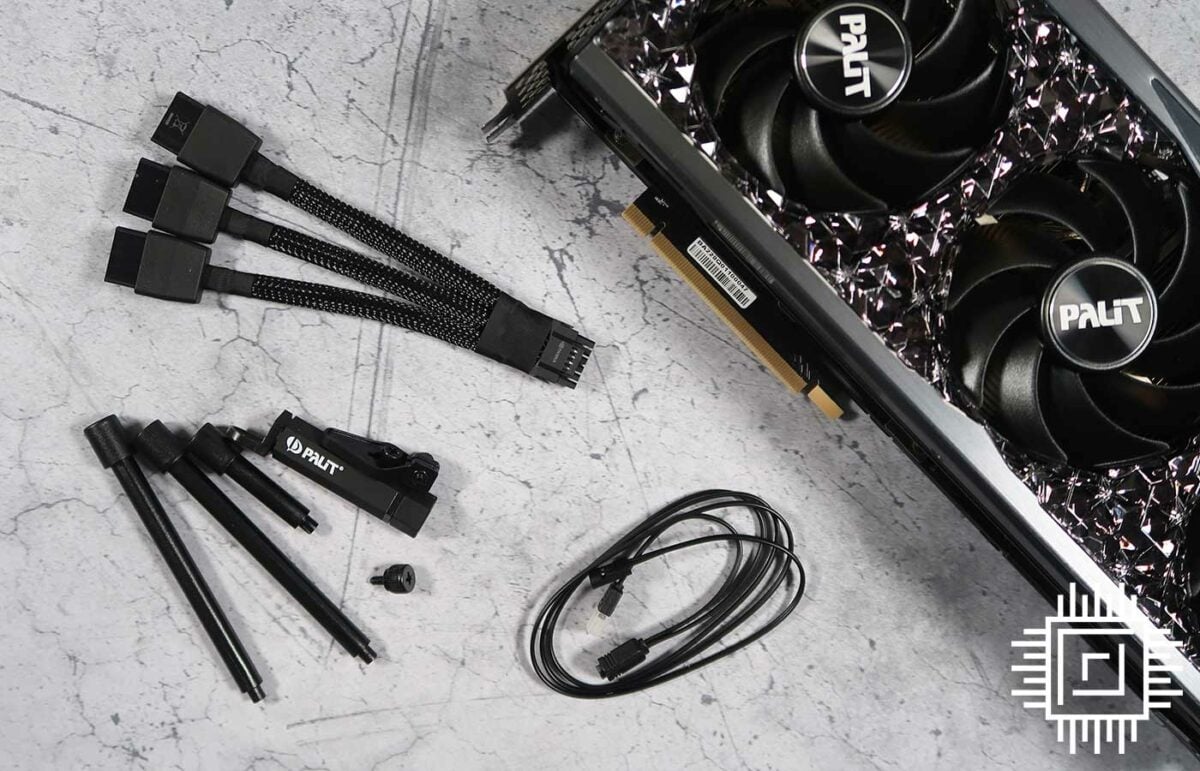
Good looks are backed by robust specs. Palit’s 329mm x 138mm x 72mm beastie weighs almost 2kg, occupies the best part of four slots and packs just about everything you’d expect from a high-end card. Metal backplate? Check. Three fans that switch off entirely at low load? Check. Vapour-chamber cooling? Check. Dual BIOS? Check. The BIOS toggle switch is frustratingly difficult to get to, however, and unless you have an ATX 3.0 power supply, tidy cabling is tricky to achieve. Whatever you do, don’t bend the adapter too far, and ensure it is fully inserted.
Such is the nature of Nvidia’s engorged Founders Edition that we don’t expect partner cards to deliver any meaningful benefit with regards to cooling or acoustics. What you might get is a little extra speed, and Palit obliges by raising out-the-box boost clock from 2,505MHz to 2,640MHz. A ~5 per cent increase is hardly worth writing home about, but on-paper numbers rarely tell the full story.
Inside our real-world test platform, Nvidia’s Founders Edition is found to settle at around the 2.75GHz mark. Palit’s GameRock OC routinely gets up to 2.9GHz, representing a 150MHz increase that translates to a few extra frames per second when gaming. 16GB of GDDR6X memory, as expected, is stock clocked at an effective 22.4Gbps.
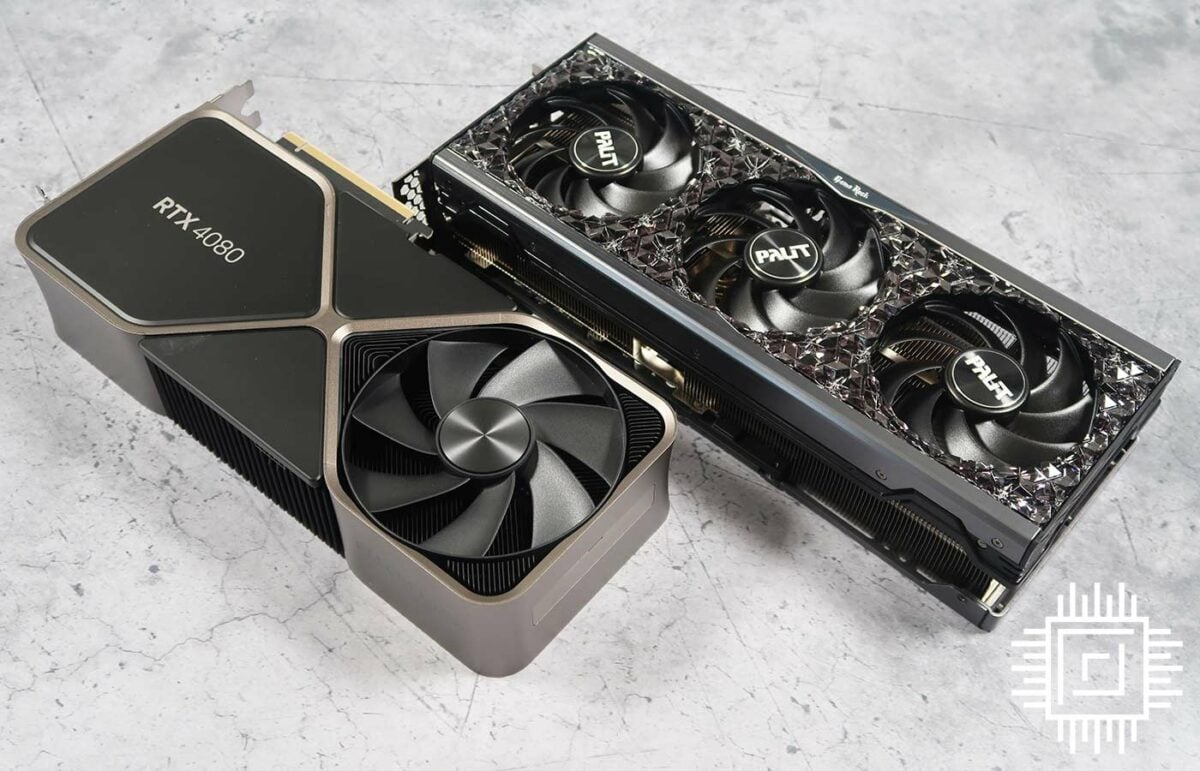
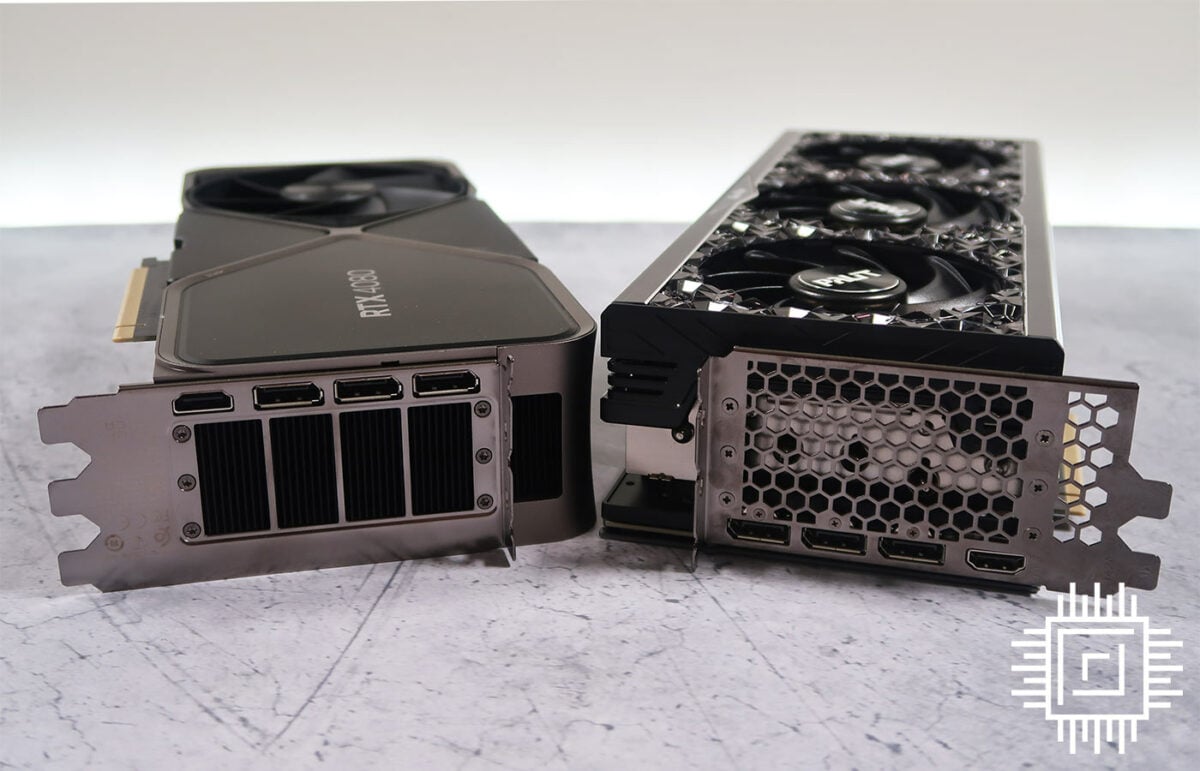
Big or bigger is the question when choosing an RTX 4080. Palit knows better than to mess with display outputs – it’s the usual quartet of HDMI 2.1 and three DisplayPort 1.4 – but we noticed an oddity in that the backplate on our review unit is unusually warped. You can make out the bend in the images if you look for it, and though performance isn’t affected in any way, overall card rigidity suffers when the ‘anti-gravity plate’ extends only the length of the relatively short PCB. FE feels the more bullet proof of the two.
Factory-overclocked benchmark numbers await, but first, a recap on everything you need to know about Nvidia’s latest Ada Lovelace architecture.
A Chip Off The Old Block
Those of you craving benchmark numbers can skip right ahead – they’re worth the wait – but for the geeks among us, let’s begin with all that’s happening beneath RTX 40 Series’ hood.
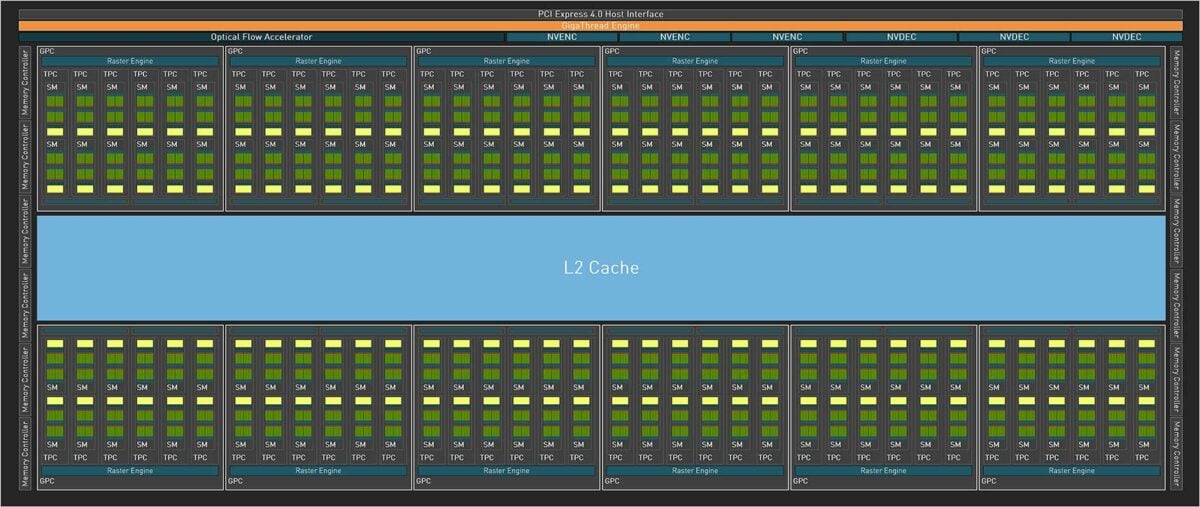
What you’re looking at is one of the most complex consumer GPUs to date. Nvidia’s 608mm2 die, fabricated on a TSMC 4N process, packs a scarcely believable 76.3 billion transistors. Putting that figure into perspective, the best GeForce chip of the previous 8nm generation, GA102, measures 628mm2 yet accommodates a puny 28.3 billion transistors. Nvidia has effectively jumped two nodes in one fell swoop, as Samsung’s 8nm process is more akin to 10nm from other foundry manufacturers.
We’ve gone from flyweight to heavyweight in the space of a generation, and a 170 per cent increase in transistor count naturally bodes well for specs. A full-fat die is home to 12 graphics processing clusters (GPCs), each sporting a dozen streaming multiprocessors (SMs), six texture processing clusters (TPCs) and 16 render output units (ROPs). Getting into the nitty-gritty of the block diagram, each SM carries 128 CUDA cores, four Tensor cores, one RT core and four texture units.
All told, Ada presents a staggering 18,432 CUDA cores in truest form, representing a greater than 70 per cent hike over last-gen champion, RTX 3090 Ti. Plenty of promise, yet to the frustration of performance purists, Nvidia chooses not to unleash the full might of Ada in the first wave. The initial RTX 40 Series duo shapes up as follows:
| GeForce | RTX 4090 | RTX 4080 | RTX 3090 Ti | RTX 3080 Ti | RTX 3080 12GB |
|---|---|---|---|---|---|
| Launch date | Oct 2022 | Nov 2022 | Mar 2022 | Jun 2021 | Jan 2022 |
| Codename | AD102 | AD103 | GA102 | GA102 | GA102 |
| Architecture | Ada Lovelace | Ada Lovelace | Ampere | Ampere | Ampere |
| Process (nm) | 4 | 4 | 8 | 8 | 8 |
| Transistors (bn) | 76.3 | 45.9 | 28.3 | 28.3 | 28.3 |
| Die size (mm2) | 608.5 | 378.6 | 628.4 | 628.4 | 628.4 |
| SMs | 128 of 144 | 76 of 80 | 84 of 84 | 80 of 84 | 70 of 84 |
| CUDA cores | 16,384 | 9,728 | 10,752 | 10,240 | 8,960 |
| Boost clock (MHz) | 2,520 | 2,505 | 1,860 | 1,665 | 1,710 |
| Peak FP32 TFLOPS | 82.6 | 48.7 | 40.0 | 34.1 | 30.6 |
| RT cores | 128 | 76 | 84 | 80 | 70 |
| RT TFLOPS | 191.0 | 112.7 | 78.1 | 66.6 | 59.9 |
| Tensor cores | 512 | 304 | 336 | 320 | 280 |
| ROPs | 176 | 112 | 112 | 112 | 96 |
| Texture units | 512 | 304 | 336 | 320 | 280 |
| Memory size (GB) | 24 | 16 | 24 | 12 | 12 |
| Memory type | GDDR6X | GDDR6X | GDDR6X | GDDR6X | GDDR6X |
| Memory bus (bits) | 384 | 256 | 384 | 384 | 384 |
| Memory clock (Gbps) | 21 | 22.4 | 21 | 19 | 19 |
| Bandwidth (GB/s) | 1,008 | 717 | 1,008 | 912 | 912 |
| L1 cache (MB) | 16 | 9.5 | 10.5 | 10 | 8.8 |
| L2 cache (MB) | 72 | 64 | 6 | 6 | 6 |
| Power (watts) | 450 | 320 | 450 | 350 | 350 |
| Launch MSRP ($) | 1,599 | 1,199 | 1,999 | 1,199 | 799 |
Leaving scope for a fabled RTX 4090 Ti, inaugural RTX 4090 disables a single GPC, enabling 128 of 144 possible SMs. Resulting figures of 16,384 CUDA cores, 128 RT cores and 512 Tensor cores remain mighty by comparison, and frequency headroom on the 4nm process is hugely impressive, with Nvidia specifying a 2.5GHz boost clock. The madness of Nvidia’s flagship is reflected in peak teraflops, which more than doubles from 40 on RTX 3090 Ti to an incredulous 82.6 on RTX 4090.
Front-end RTX 40 Series specifications are eye-opening, but the back end is noticeably less revolutionary, where a familiar 24GB of GDDR6X memory operates at 21Gbps, providing 1,008GB/s of bandwidth. The needle hasn’t moved – Nvidia has opted against Micron’s quicker 24Gbps chips – however the load on memory has softened with a significant bump in on-chip cache.
RTX 4090 carries 16MB of L1 and 72MB of L2. We’ve previously seen AMD attach as much as 128MB Infinity Cache on Radeon graphics cards, and though Nvidia doesn’t detail data rates or clock cycles, a greater than 5x increase in cache between generations reduces the need to routinely spool out to memory, raising performance and reducing latency.
Heard rumours of RTX 40 Series requiring a nuclear reactor to function? Such reports were wide of the mark. RTX 4090 maintains the same 450W TGP as RTX 3090 Ti, while RTX 4080 scales down to 320W. Almost 10 per cent lower than the last-generation x80 equivalent.
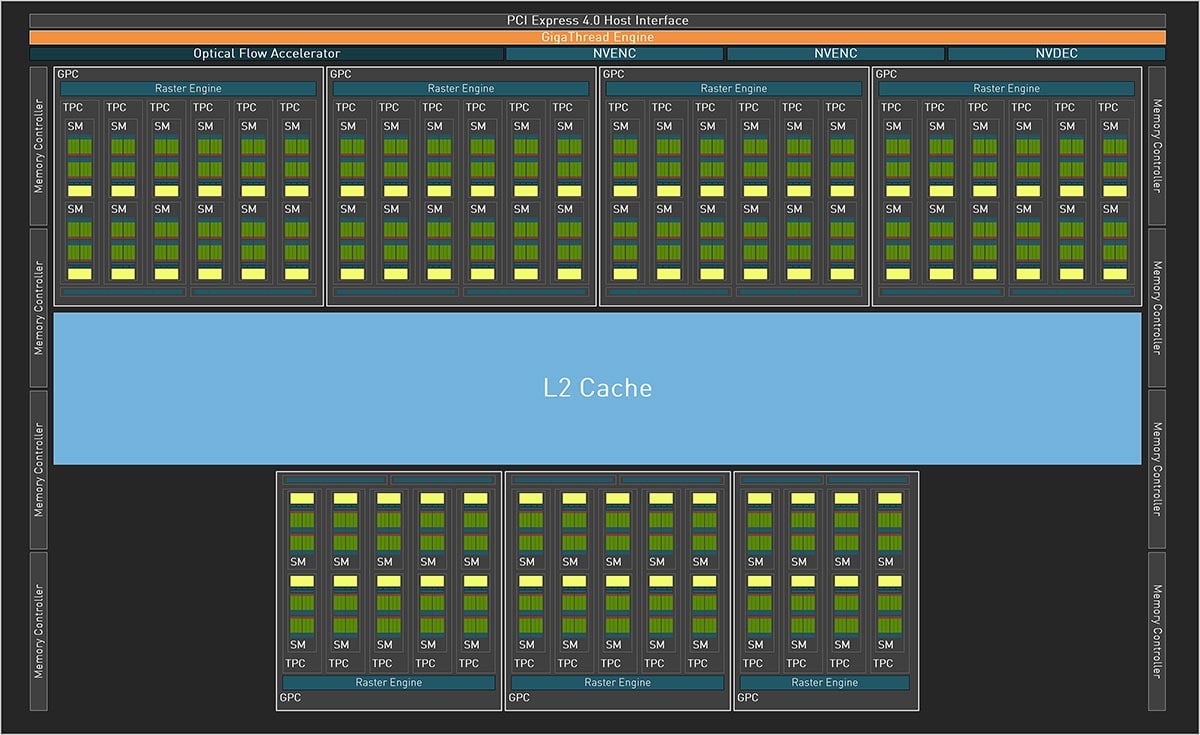
Shifting focus to RTX 4080, it is instructive to know Nvidia is not repurposing the same die across multiple high-end SKUs, as was the case with the previous generation. Instead, RTX 4080 calls upon newfound AD103 silicon but once again falls short of full implementation, featuring 76 of 80 possible active SMs.
Core count is cleaved by over 40 per cent from 16,384 on RTX 4090 to 9,728 on RTX 4080. RT and Tensor cores are slashed proportionally to 76 and 304, respectively, while onboard GDDR6X memory not only drops from 24GB to 16GB, bus width is also narrowed from 384 bits to just 256. Savage cuts on paper, and certain specifications intimate a sideward step alongside existing parts. You’ll have noticed RTX 4080 has fewer CUDA, RT and Tensor cores than RTX 3080 Ti, so what gives?
NVIDIA HAS KEPT THE DOOR AJAR FOR A POTENTIAL RTX 4080 TI WITH A FULL COMPLEMENT OF 80 ACTIVE SMS
In addition to a treasure chest of Ada Lovelace architecture optimisations, the 4nm process enables significantly higher clocks – RTX 4080 is binned to operate at effectively the same 2.5GHz as RTX 4090 – and such lofty frequencies ensure peak teraflops best the previous-generation champion, RTX 3090 Ti, to the tune of 22 per cent. Memory clock is also upped from 21Gbps on RTX 4090 to 22.4Gbps on RTX 4080, to help mitigate the tighter bus, and let’s not forget the 64MB of L2 cache, representing a generational increase of over 10x.
Leaving plenty of room to manoeuvre, Nvidia has kept the door ajar for a potential RTX 4080 Ti with a full complement of 80 active SMs, and as for the ill-fated RTX 4080 12GB, well, the less said the better. Word on the grapevine is the third-rung $899 GPU will eventually see the light of day under new guise as RTX 4070 Ti in 2023.
Outside of core specifications, display outputs remain tied to HDMI 2.1 and DisplayPort 1.4a – DisplayPort 2.0 hasn’t made the cut – and PCIe Gen 4 continues as the preferred interface. There’s no urgency to switch to Gen 5, says Nvidia, as even RTX 4090 can’t saturate the older standard. Finally, NVLink is conspicuous by its absence; SLI is nowhere to be seen on any RTX 40 Series product announced thus far, signalling multi-GPU setups are well and truly dead.
Ada Optimisations
While a shift to a smaller node affords more transistor firepower, such a move typically precludes sweeping changes to architecture. Optimisations and resourcefulness are order of the day, and the huge computational demands of raytracing are such that raw horsepower derived from a 3x increase in transistor budget isn’t enough; something else is needed, and Ada Lovelace brings a few neat tricks to the table.
Nvidia often refers to raytracing as a relatively new technology, stressing that good ol’ fashioned rasterisation has been through wave after wave of optimisation, and such refinement is actively being engineered for RT and Tensor cores. There’s plenty of opportunity where low-hanging fruit is yet to be picked.
Shader Execution Reordering
Shaders have been running efficiently for years, whereby one instruction is executed in parallel across multiple threads. You may know it as SIMT.
Raytracing, however, throws a spanner in those smooth works, as while pixels in a rasterised triangle lend themselves to running concurrently, keeping all lanes occupied, secondary rays are divergent by nature and the scattergun approach of hitting different areas of a scene leads to massive inefficiency through idle lanes.

Ada’s fix, dubbed Shader Execution Reordering (SER), is a new stage in the raytracing pipeline tasked with scanning individual rays on the fly and grouping them together. The result, going by Nvidia’s internal numbers, is a 2x improvement in raytracing performance in scenes with high levels of divergence.
Nvidia portentously claims SER is “as big an innovation as out-of-order execution was for CPUs.” A bold statement and there is a proviso in that Shader Execution Reordering is an extension of Microsoft’s DXR APIs, meaning it us up to developers to implement and optimise SER in games.
There’s no harm in having the tools, mind, and Nvidia is quickly discovering that what works for rasterisation can evidently be made to work for RT.
Upgraded RT Cores
In the rasterisation world, geometry bottlenecks are alleviated through mesh shaders. In a similar vein, displaced micro-meshes aim to echo such improvements in raytracing.
“THE ERA OF BRUTE-FORCE GRAPHICS RENDERING IS OVER”BRYAN CATANZARO, NVIDIA VP OF APPLIED DEEP LEARNING RESEARCH
With Ampere, the Bounding Volume Hierarchy (BVH) was forced to contain every single triangle in the scene, ready for the RT core to sample. Ada, in contrast, can evaluate meshes within the RT core, identifying a base triangle prior to tessellation in an effort to drastically reduce storage requirements.
A smaller, compressed BVH has the potential to enable greater detail in raytraced scenes with less impact on memory. Having to insert only the base triangles, BVH build times are improved by an order of magnitude and data sizes shrink significantly, helping reduce CPU overhead.
The sheer complexity of raytracing is such that eliminating unnecessary shader work has never been more important. To that end, an Opacity Micromap Engine has also been added to Ada’s RT core to reduce the amount of information going back and forth to shaders.
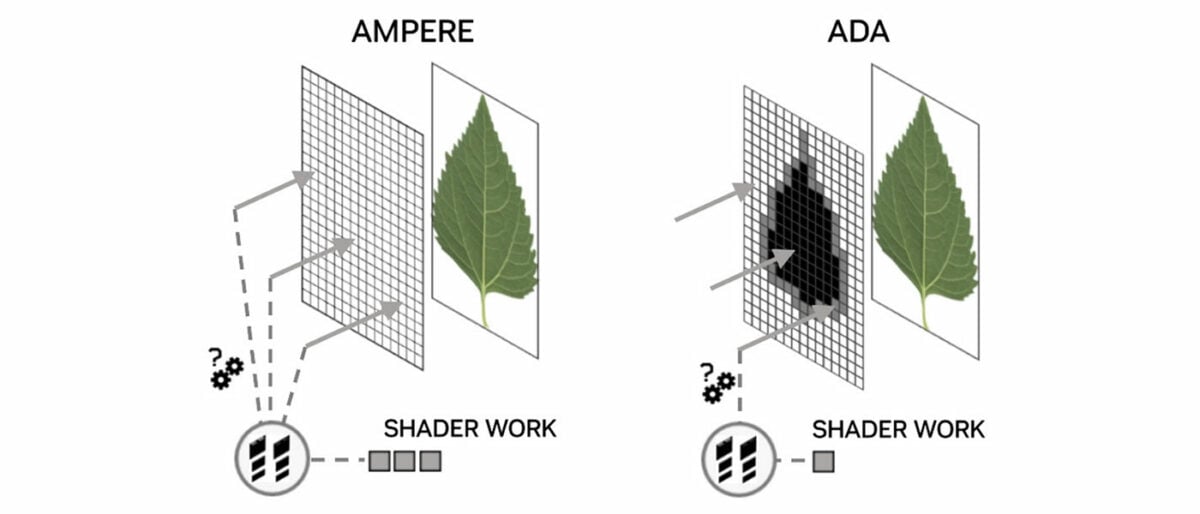
In the common leaf example, developers place the texture of foliage within a rectangle and use opaque polygons to determine the leaf’s position. A way to construct entire trees efficiently, yet with Ampere the RT core lacked this basic ability, with all rays passed back to the shader to determine which areas are opaque, transparent, or unknown. Ada’s Opacity Micromap Engine can identify all the opaque and transparent polygons without invoking any shader code, resulting in 2x faster alpha traversal performance in certain applications.
These two new hardware units make the third-generation RT core more capable than ever before – TFLOPS per RT core has risen by ~65 per cent between generations – yet all this isn’t enough to back up Nvidia’s claims of Ada Lovelace delivering up to 4x the performance of the previous generation. For that, Team Green continues to rely on AI.
DLSS 3
Since 2019, Deep Learning Super Sampling has played a vital role in GeForce GPU development. Nvidia’s commitment to the tech is best expressed by Bryan Catanzaro, VP of applied deep learning research, who states with no uncertainty that “the era of brute-force graphics rendering is over.”
Third-generation DLSS, deemed a “total revolution in neural graphics,” expands upon DLSS Super Resolution’s AI-trained upscaling by employing optical flow estimation to generate entire frames. Through a combination of DLSS Super Resolution and DLSS Frame Generation, Nvidia reckons DLSS 3 can now reconstruct seven-eighths of a game’s total displayed pixels, to dramatically increase performance and smoothness.
Generating so much on-screen content without invoking the shader pipeline would have been unthinkable just a few years ago. It is a remarkable change of direction, but those magic extra frames aren’t conjured from thin air. DLSS 3 takes four inputs – two sequential in-game frames, an optical flow field and engine data such as motion vectors and depth buffers – to create and insert synthesised frames between working frames.
In order to capture the required information, Ada’s Optical Flow Accelerator is capable of up to 300 TeraOPS (TOPS) of optical-flow work, and that 2x speed increase over Ampere is viewed as vital in generating accurate frames without artifacts.
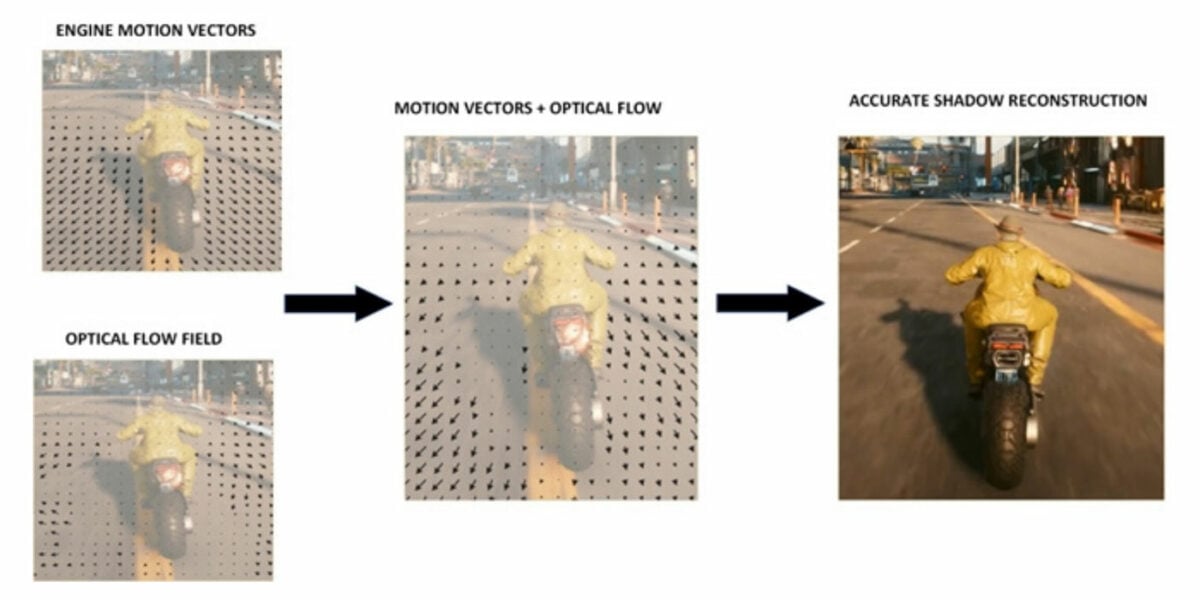
The real-world benefit of AI-generated frames is most keenly felt in games that are CPU bound, where DLSS Super Resolution can typically do little to help. Nvidia’s preferred example is Microsoft Flight Simulator, whose vast draw distances inevitably force a CPU bottleneck. Internal data suggests DLSS 3 Frame Generation can boost Flight Sim performance by as much as 2x.
Do note, also, that Frame Generation and Super Resolution can be implemented independently by developers. In an ideal world, gamers will have the choice of turning the former on/off, while being able to adjust the latter via a choice of quality settings.
More demanding AI workloads naturally warrant faster Tensor Cores, and Ada obliges by imbuing the FP8 Transformer Engine from HPC-optimised Hopper. Peak FP16 Tensor teraflops performance is already doubled from 320 on Ampere to 661 on Ada, but with added support for FP8, RTX 4090 can deliver a theoretical 1.3 petaflops of Tensor processing.
Plenty of bombast, yet won’t such processing result in an unwanted hike in latency? Such concerns are genuine; Nvidia has taken the decision to make Reflex a mandatory requirement for DLSS 3 implementation.
Designed to bypass the traditional render queue, Reflex synchronises CPU and GPU workloads for optimal responsiveness and up to a 2x reduction in latency. Ada optimisations and in particular Reflex are key in keeping DLSS 3 latency down to DLSS 2 levels, but as with so much that is DLSS related, success is predicated on the assumption developers will jump through the relevant hoops. In this case, Reflex markers must be added to code, allowing the game engine to feed back the data required to coordinate both CPU and GPU.
Given the often-sketchy state of PC game development, gamers are right to be cautious when the onus is placed in the hands of devs, and there is another caveat in that DLSS tech is becoming increasingly fragmented between generations.
DLSS 3 now represents a superset of three core technologies: Frame Generation (exclusive to RTX 40 Series), Super Resolution (RTX 20/30/40 Series), and Reflex (any GeForce GPU since the 900 Series). Nvidia has no immediate plans to backport Frame Generation to slower Ampere cards.
8th Generation NVENC
Last but not least, Ada Lovelace is wise not to overlook the soaring popularity of game streaming, both during and after the pandemic.
Building upon Ampere’s support for AV1 decoding, Ada adds hardware encoding, improving H.264 efficiency to the tune of 40 per cent. This, says Nvidia, allows streamers to bump their stream resolution to 1440p while maintaining the same bitrate.
AV1 support also bodes well for professional apps – DaVinci Resolve is among the first to announce compatibility – and Nvidia extends this potential on high-end RTX 40 Series GPUs by ensuring both launch models include dual 8th Gen NVENC encoders (enabling 8K60 capture and 2x quicker exports) as well as a 5th Gen NVDEC decoder as standard.
Performance
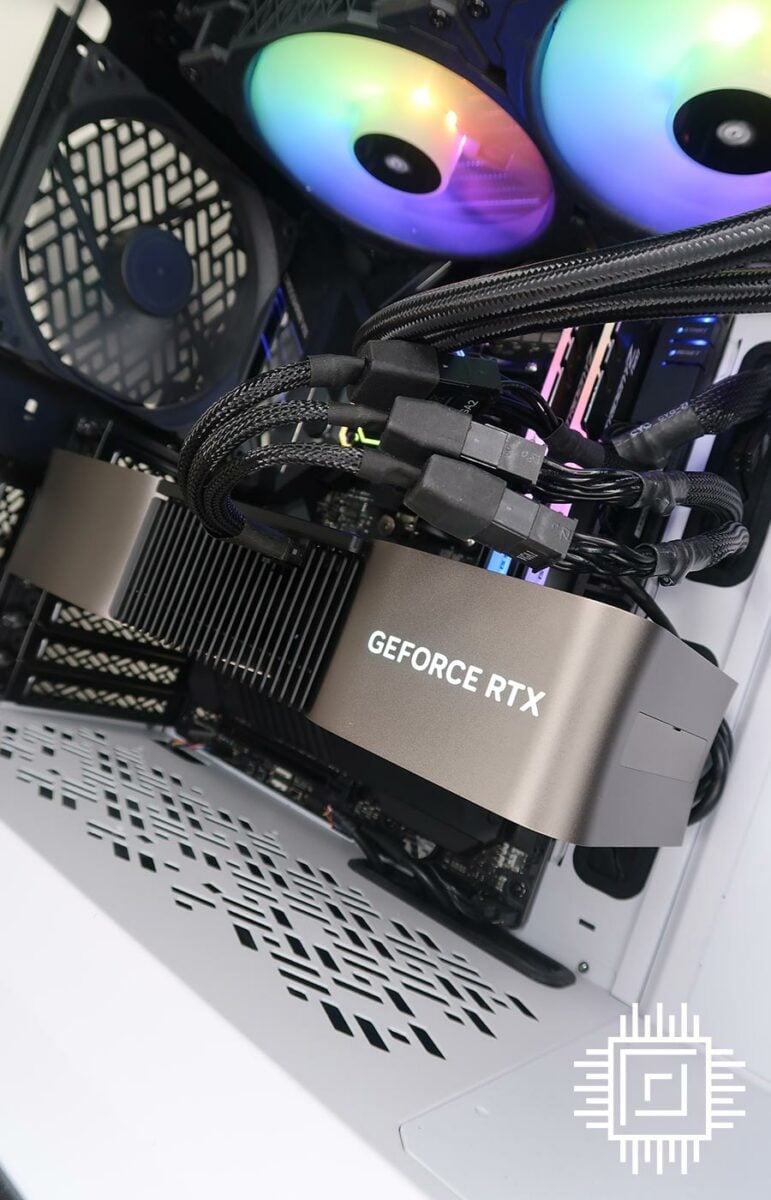
Club386 Test Platform
Processor: AMD Ryzen 9 5950X
Motherboard: Asus ROG Crosshair VII Formula
CPU Cooler: Corsair iCue H115i Elite Capellix
Memory: 64GB G.Skill Trident Z Neo DDR4-3200
Storage: 2TB Corsair MP600
Power Supply: be quiet! Straight Power 11 Platinum 1,000W
Chassis: Fractal Design Define 7 Clear Tempered Glass
Monitor: Philips Momentum 436M6VBPAB
Operating System: Microsoft Windows 11 Pro
Our trusty test platforms have been working overtime these past few months, and though the PCIe slot is starting to look worse for wear, the AM4 rigs haven’t skipped a beat. RTX 4080 locked and loaded.
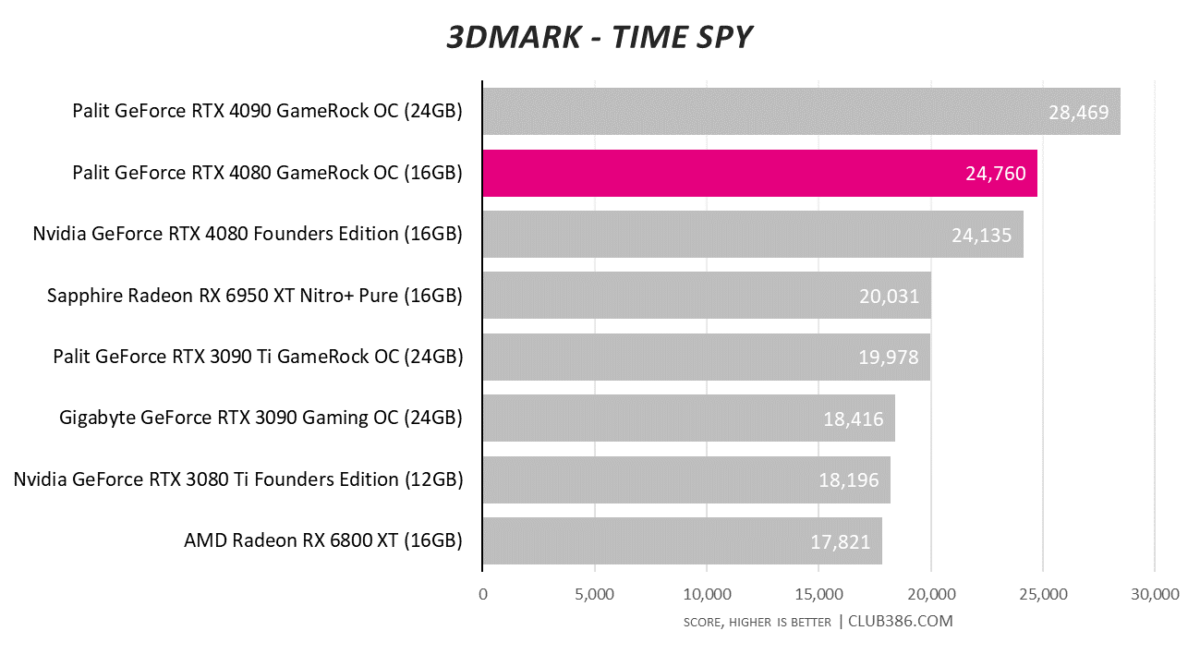

Factory-overclocked RTX 4080s naturally offer that extra smidgen of performance. We’ve now had a couple of partner 4080s in the test bench, and Palit’s GameRock OC has delivered the highest speeds to date.
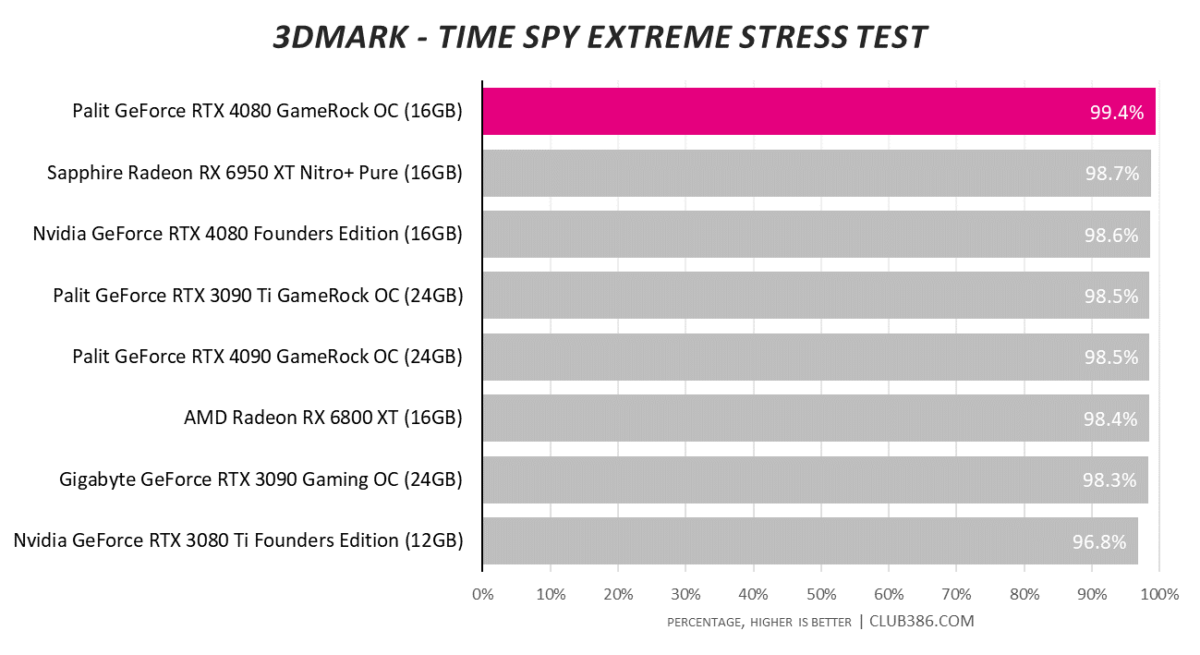
The quickest RTX 4080 also happens to be the most stable, delivering an exemplary score of 99.4 per cent in the Time Spy Extreme Stress Test.
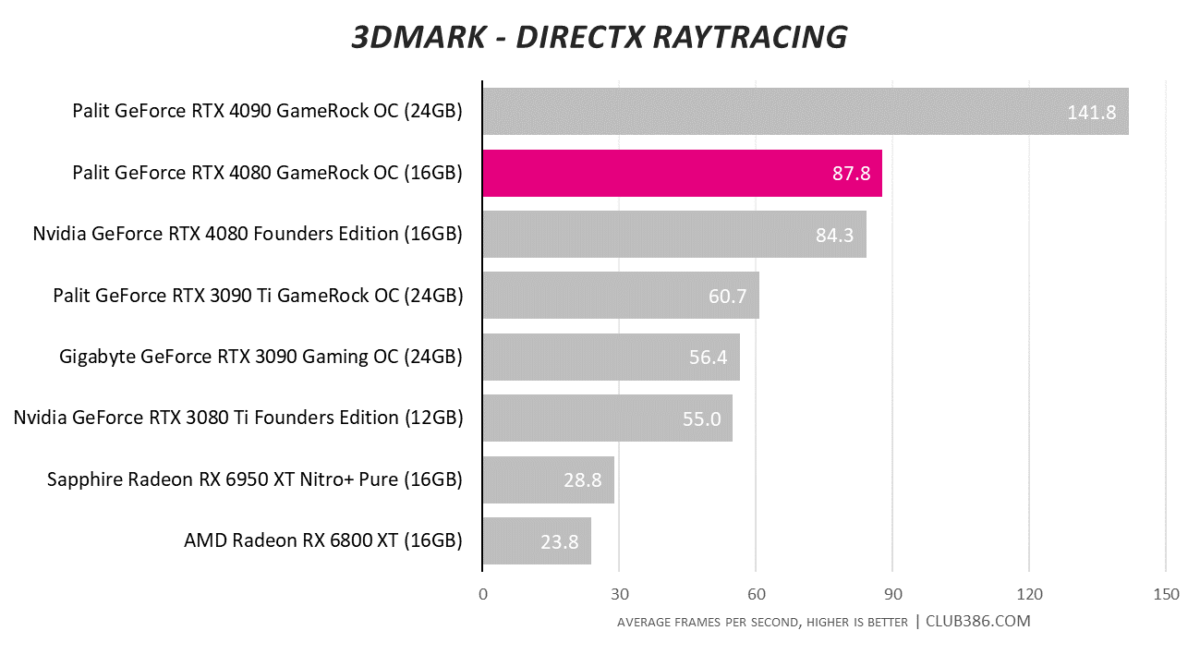
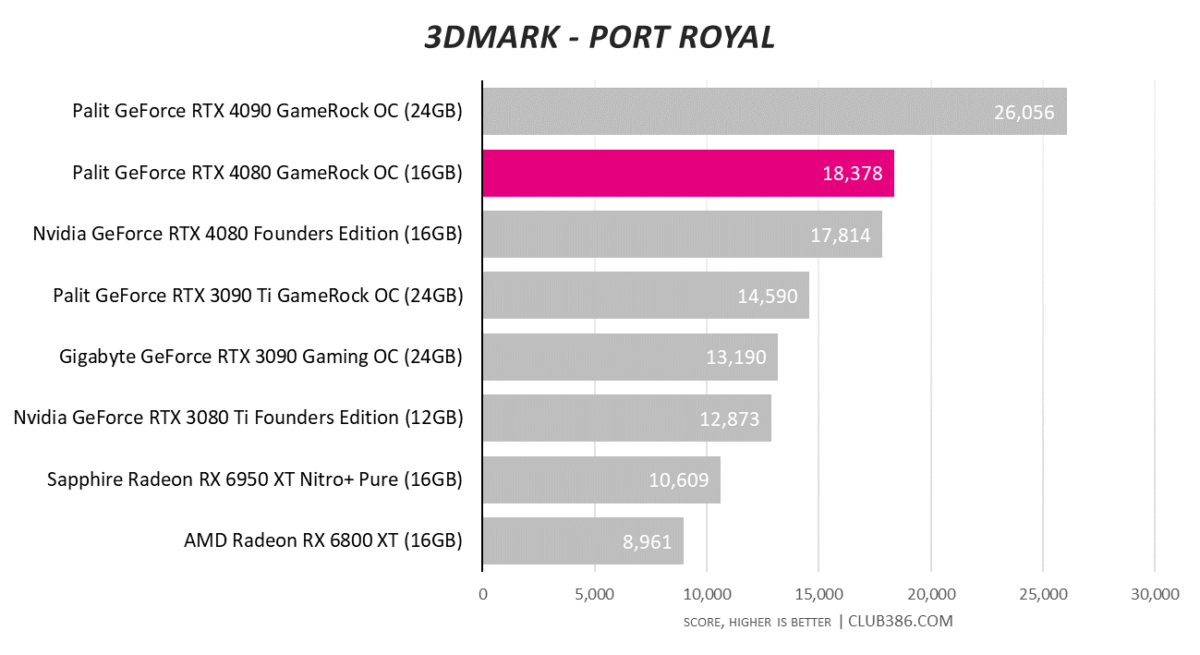
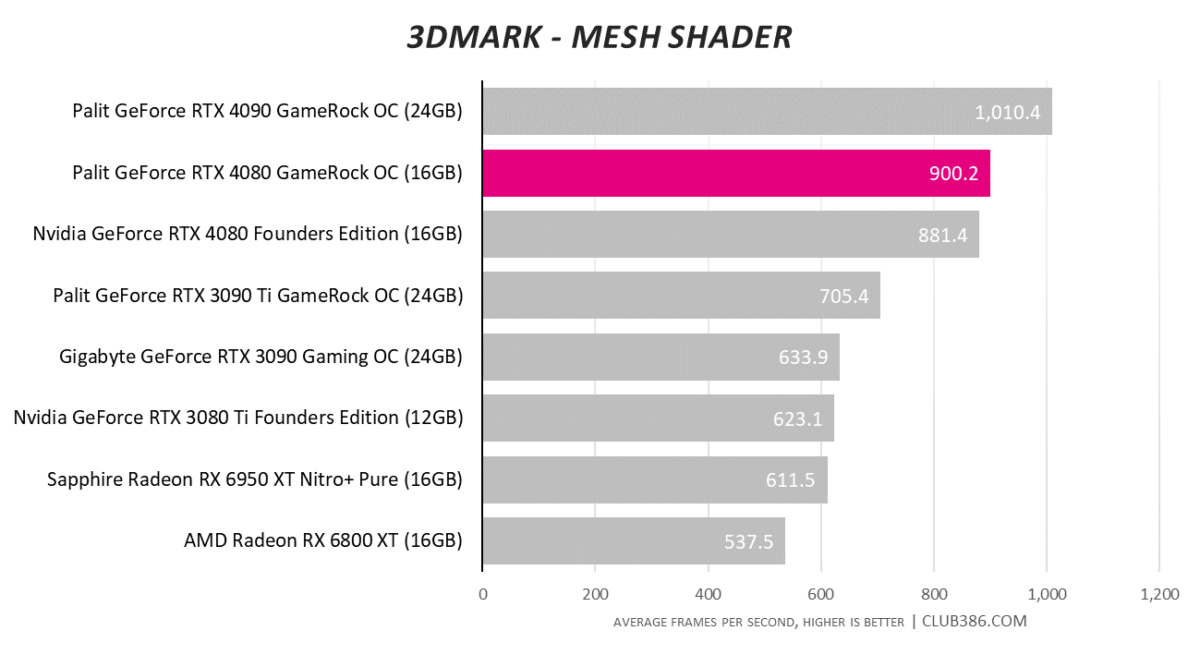
RTX 4080 is quick enough to beat anything from the previous generation, but results also reinforce that RTX 4090 is on another level entirely.
Assassin’s Creed Valhalla
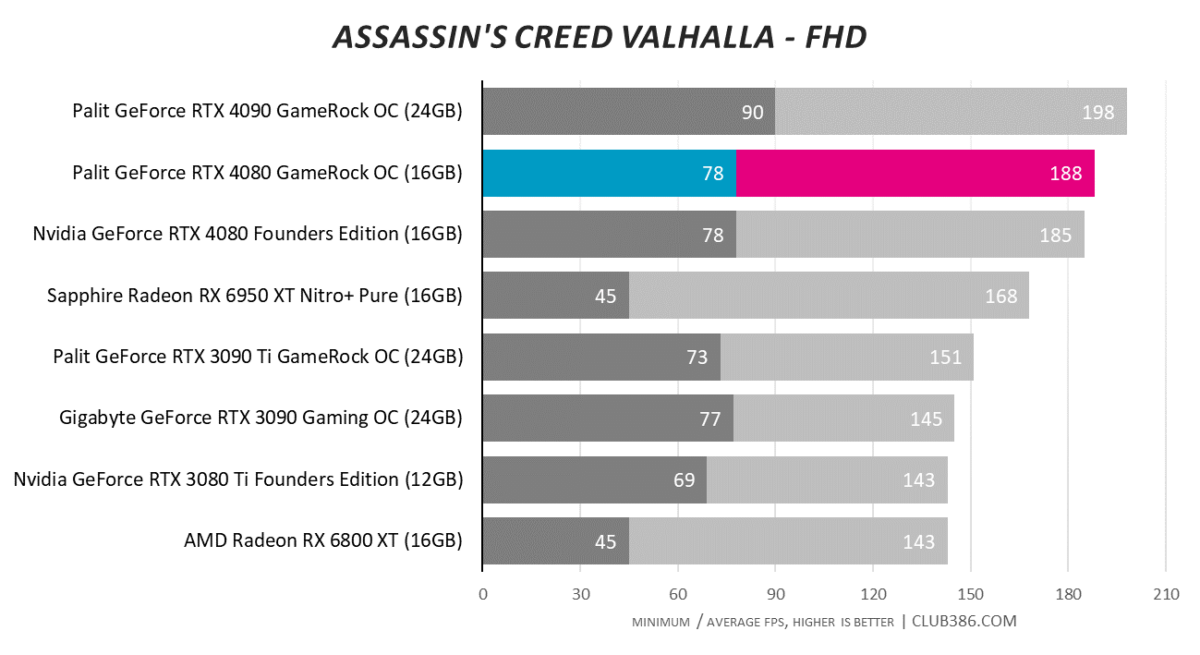
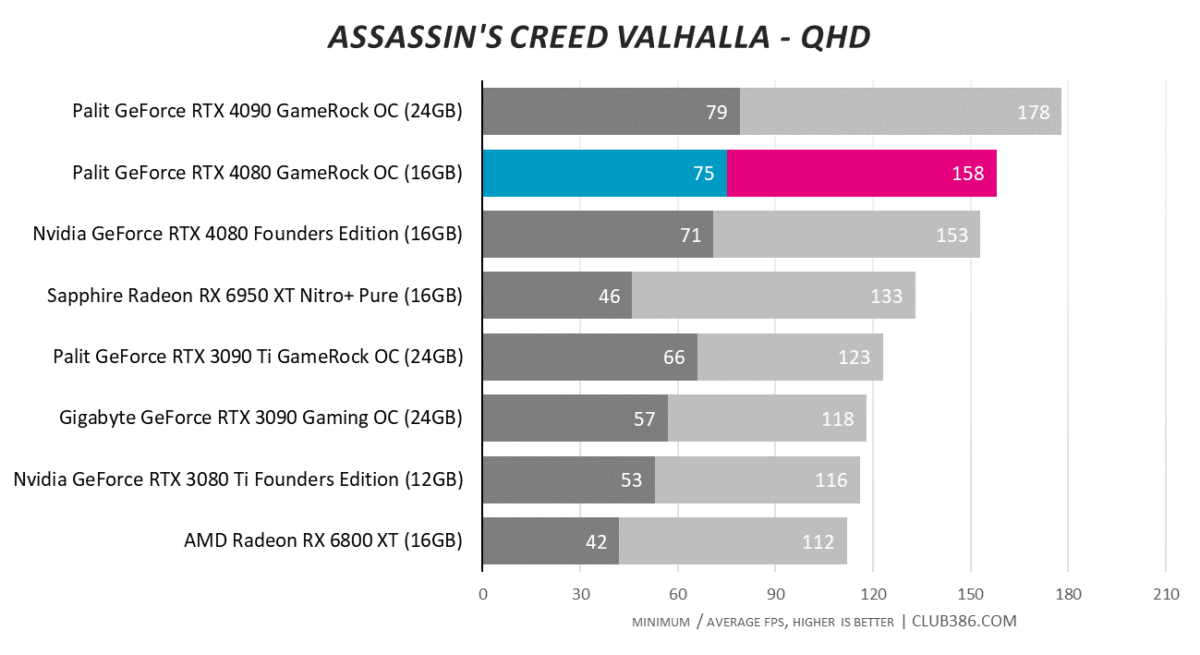
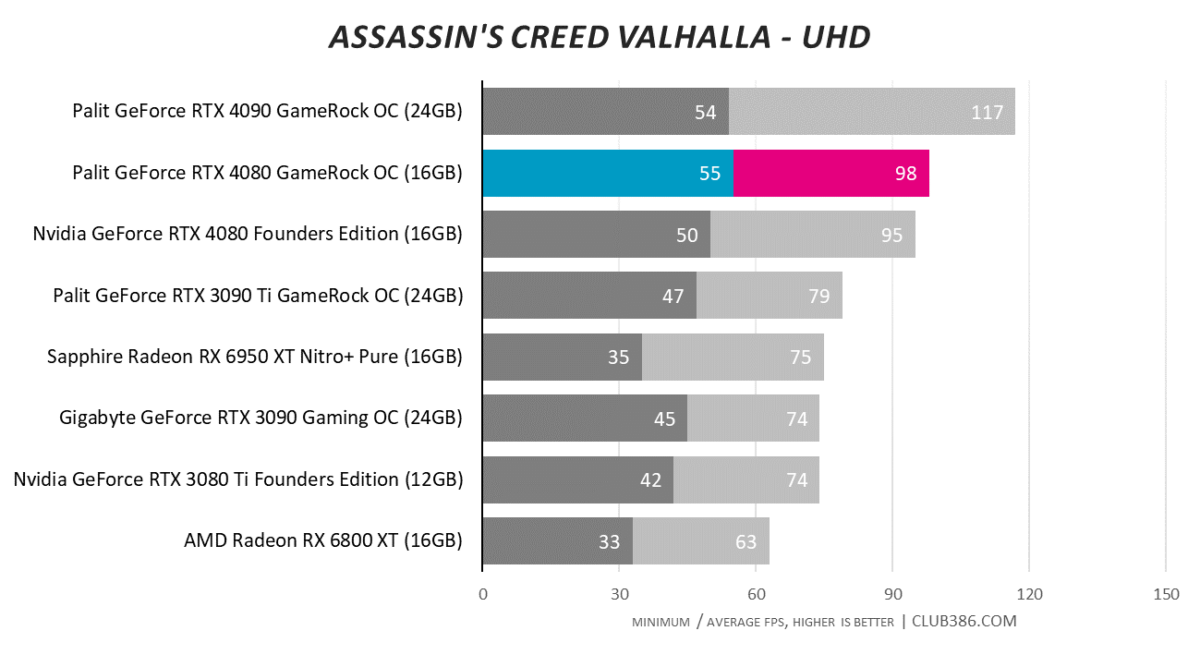
Almost 25 per cent quicker than RTX 3090 Ti at a 4K UHD resolution, RTX 4080 sets a high bar for a second-rung GPU.
Cyberpunk 2077
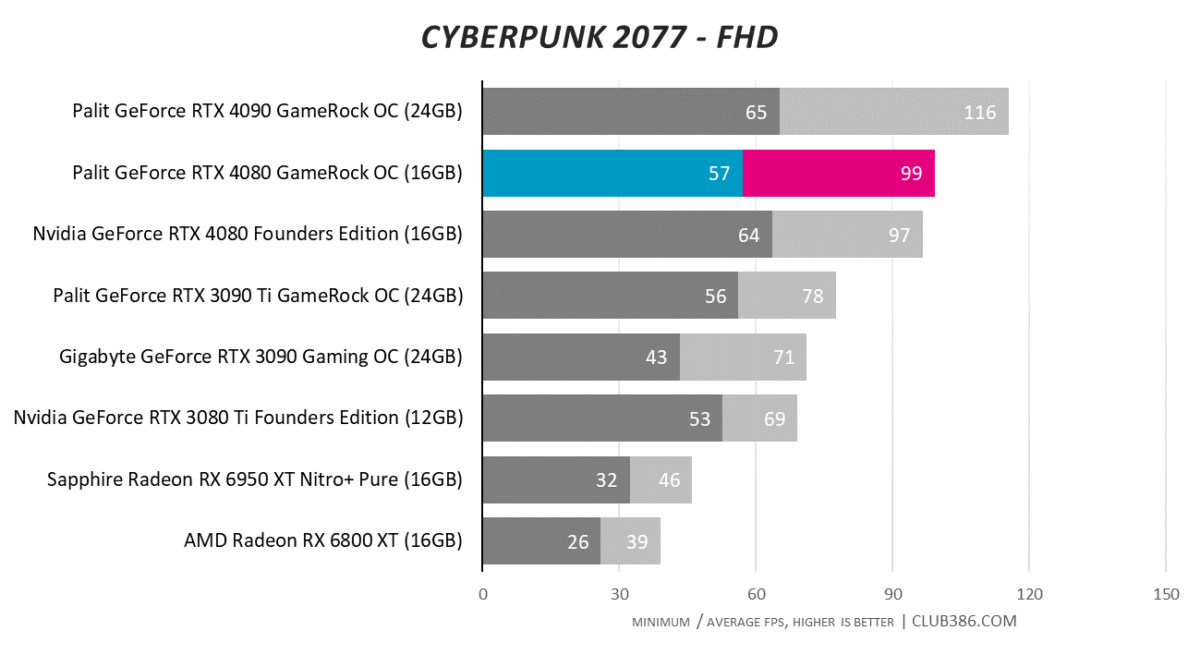
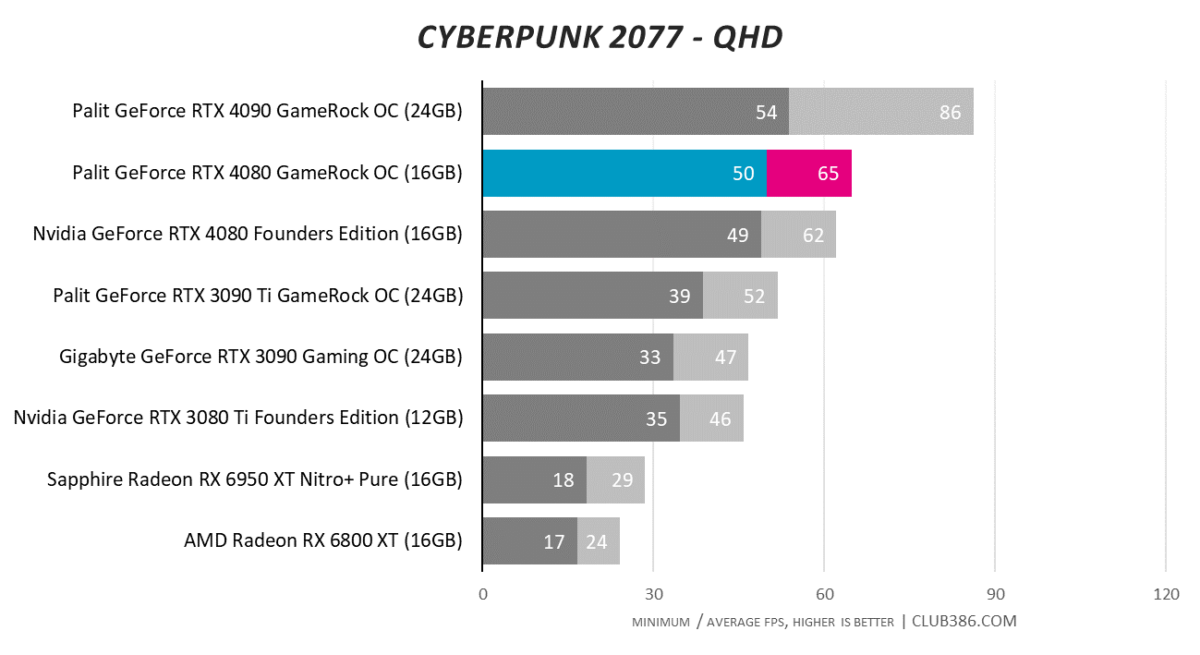
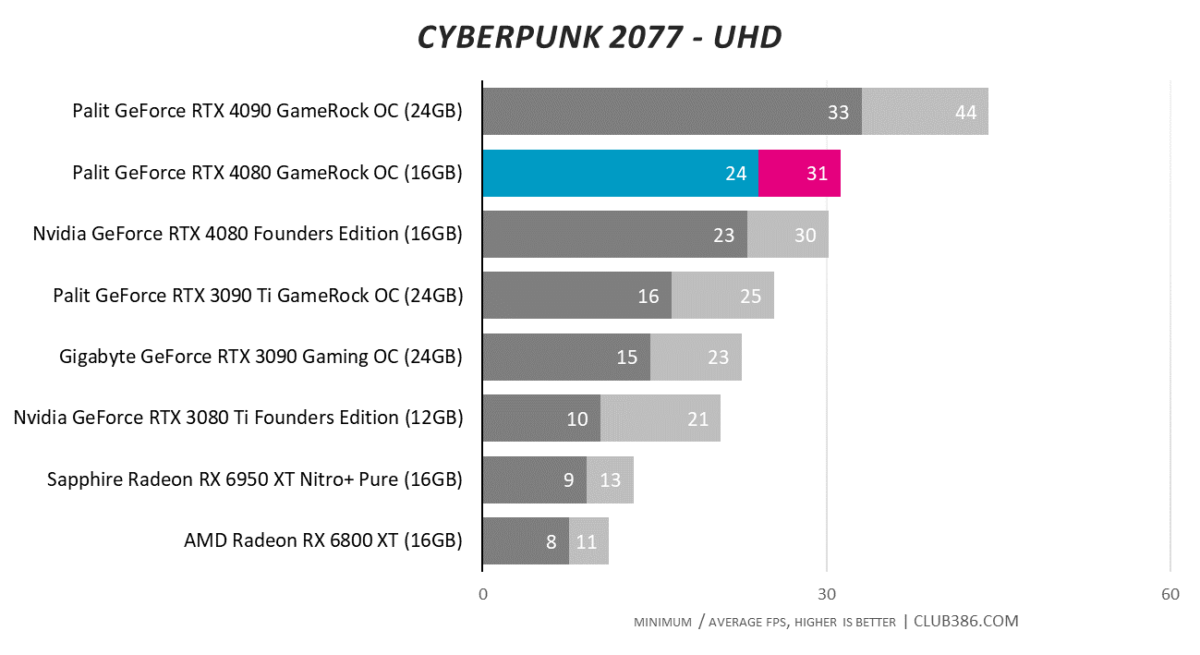
The choice between Nvidia GeForce and AMD Radeon becomes lopsided when raytraced games are added to the equation. Radeons prop up the bottom of the Cyberpunk charts across all three resolutions, and RTX 4080 is over twice as quick as Radeon RX 6950 XT in this title.
Far Cry 6
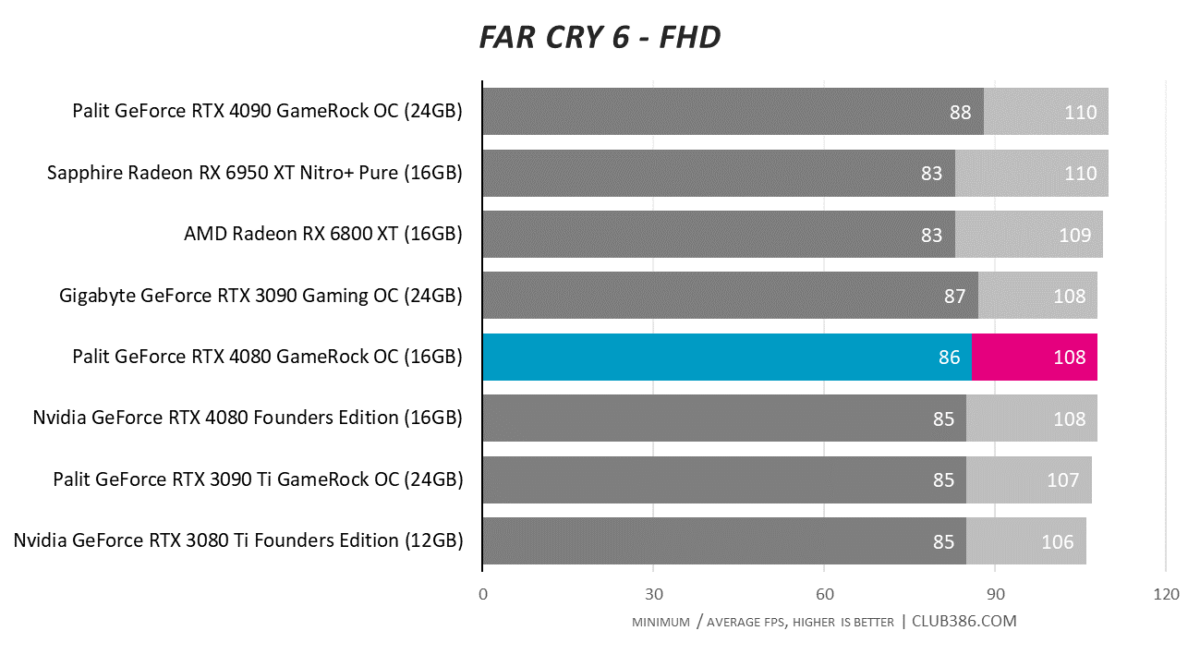
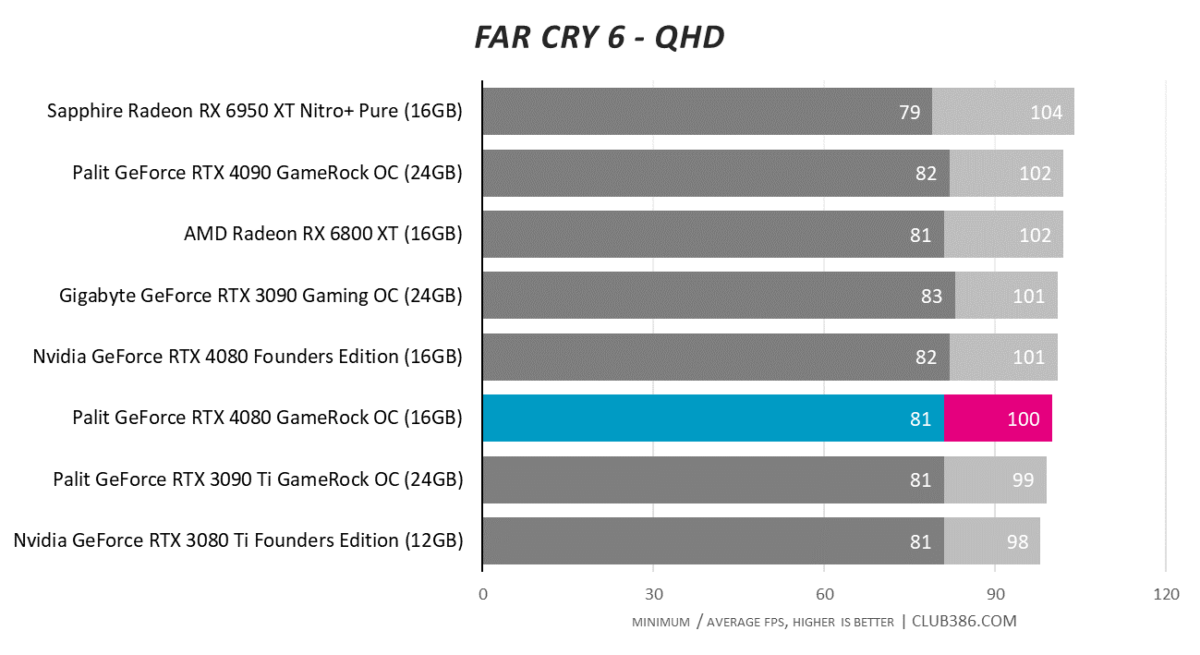
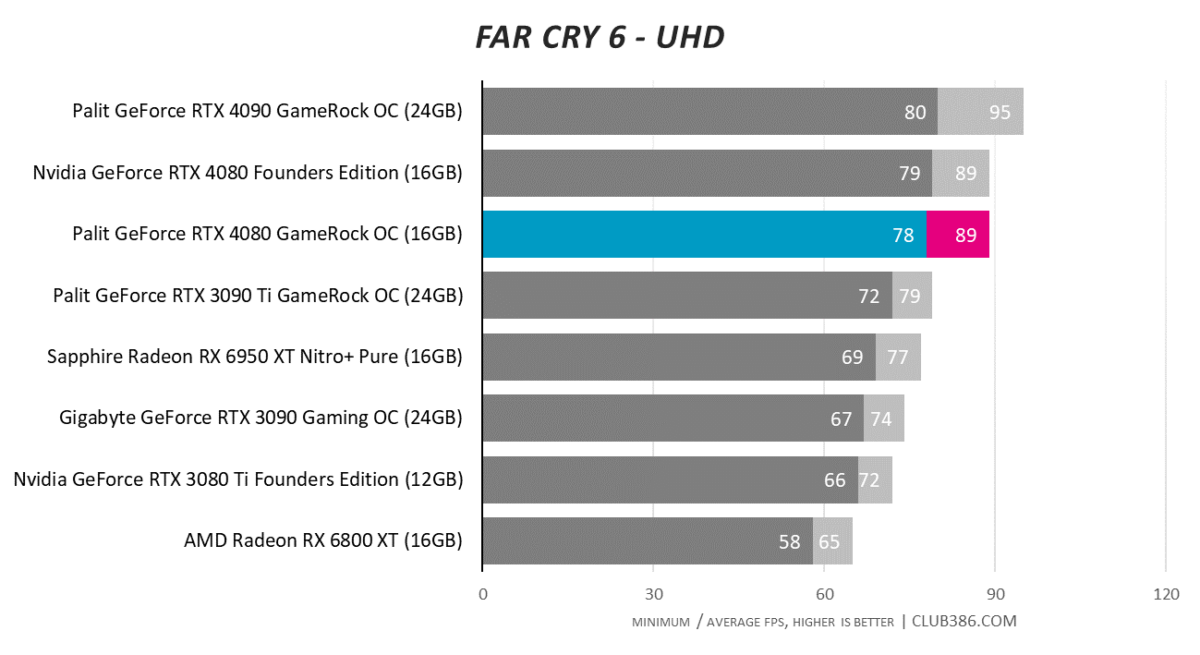
Already factored an RTX 4080 into your build plans? Consider a high-speed, high-res display to go with. 4K 144Hz ought to do it.
Final Fantasy XIV: Endwalker
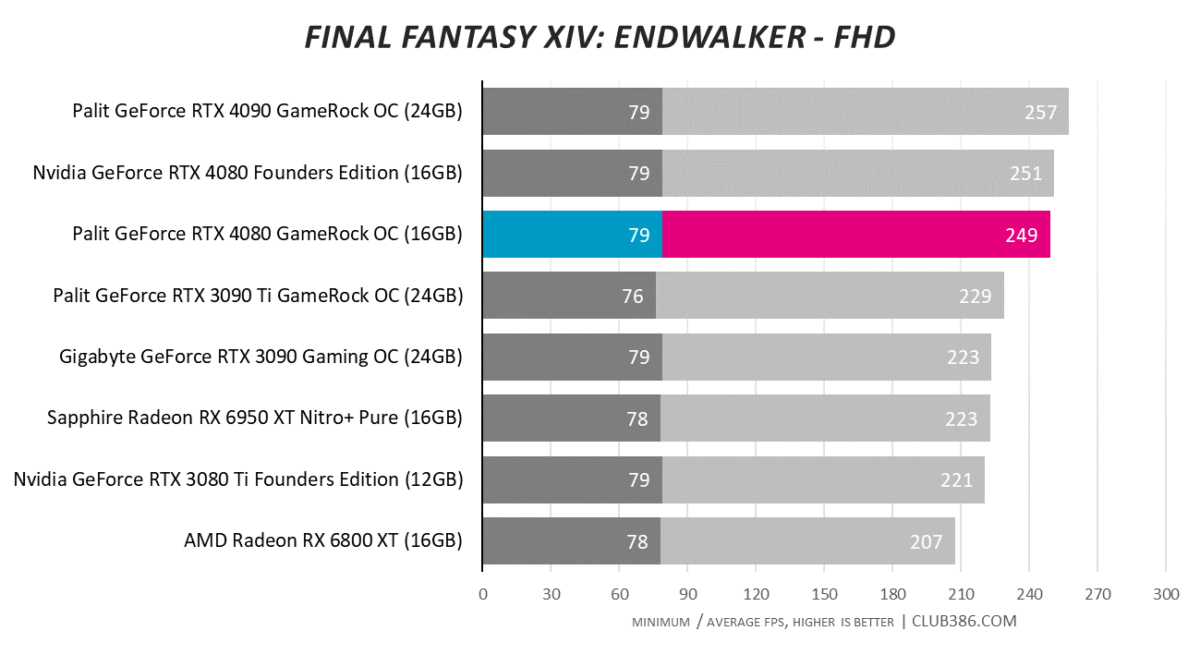
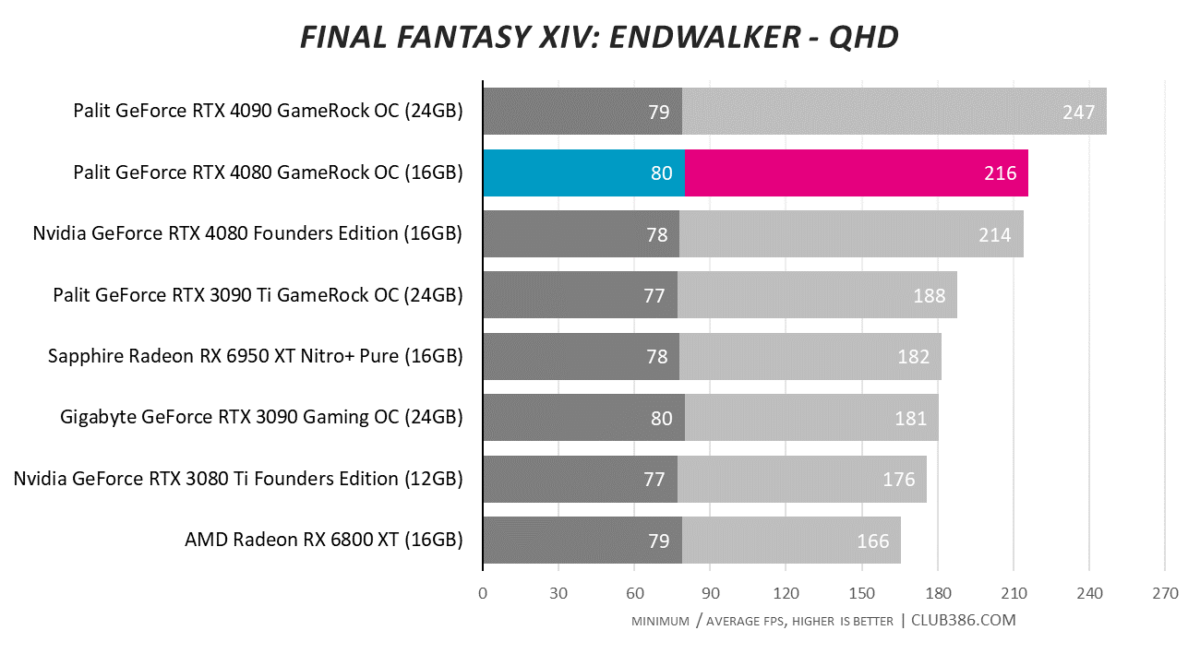
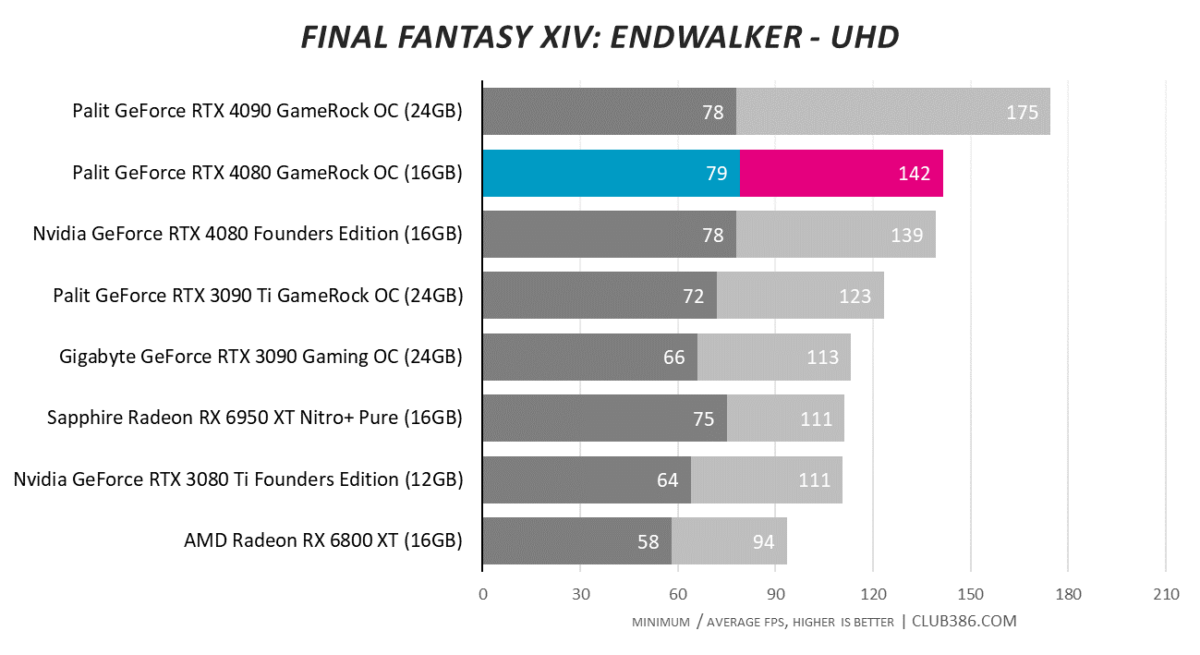
RTX 4080 pricing absolutely needs to stay well clear of RTX 4090. Nvidia’s top dog barks loudest.
Forza Horizon 5
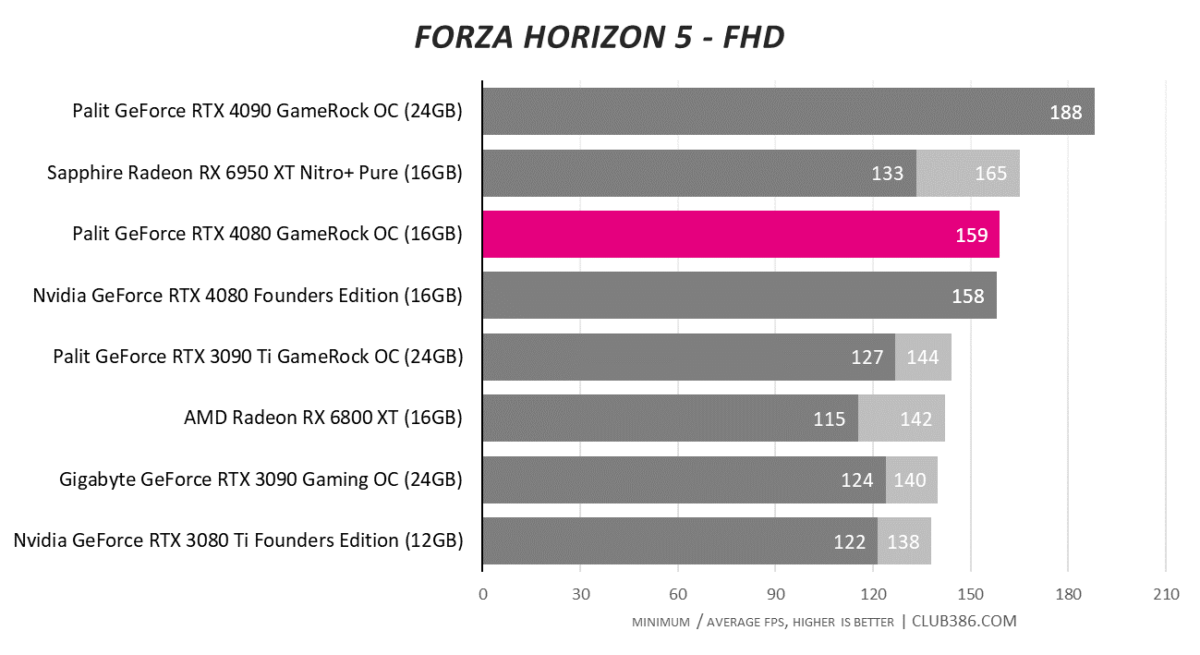
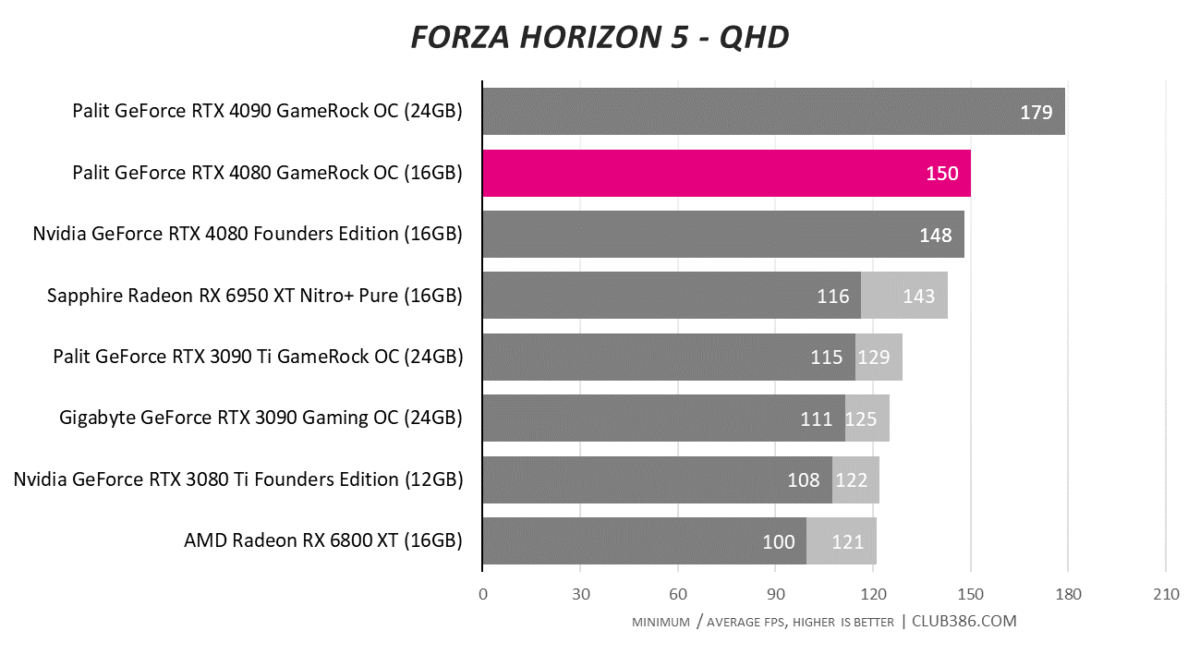
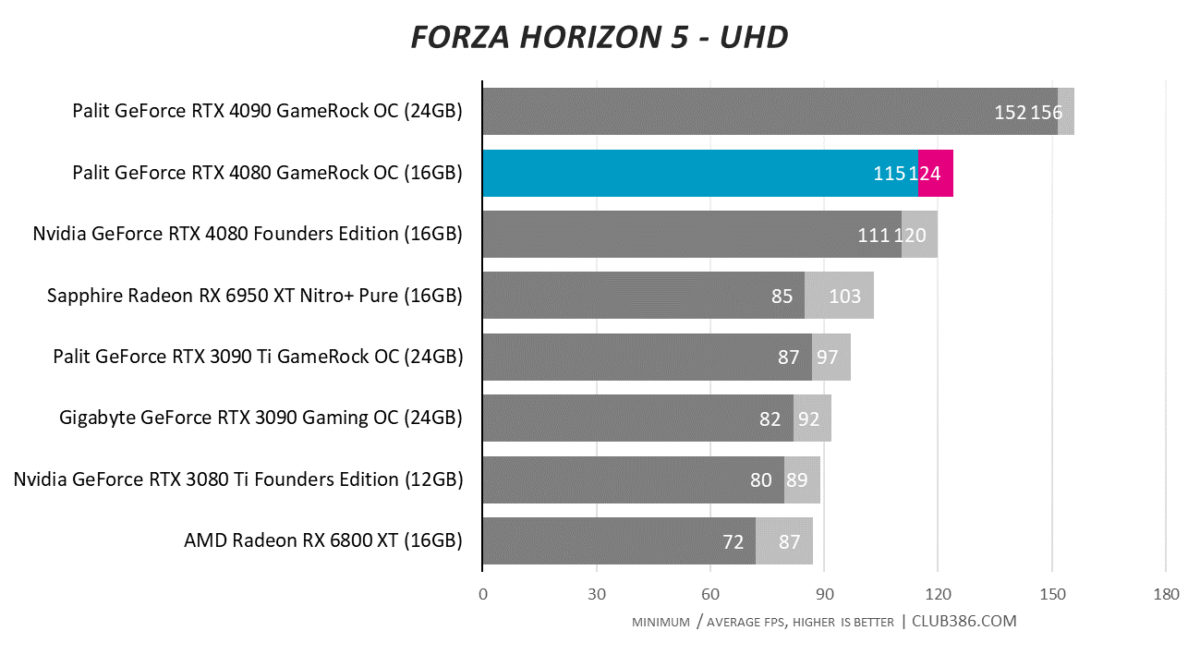
4K120? That’ll do nicely, thank you very much.
Marvel’s Guardians of the Galaxy
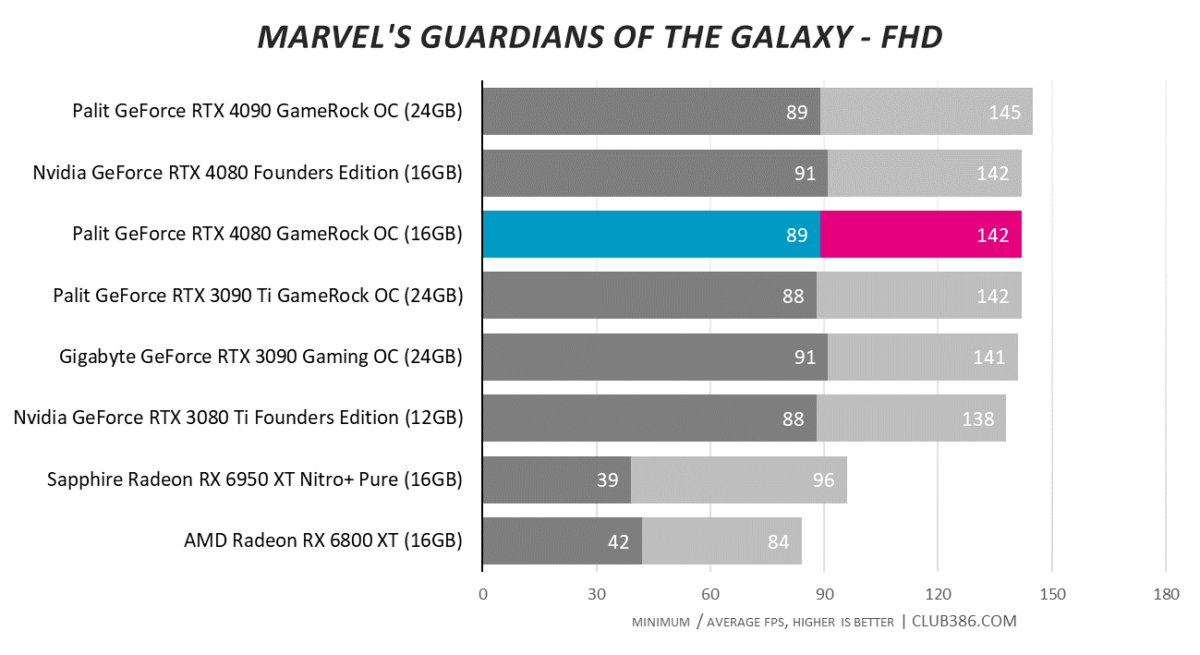
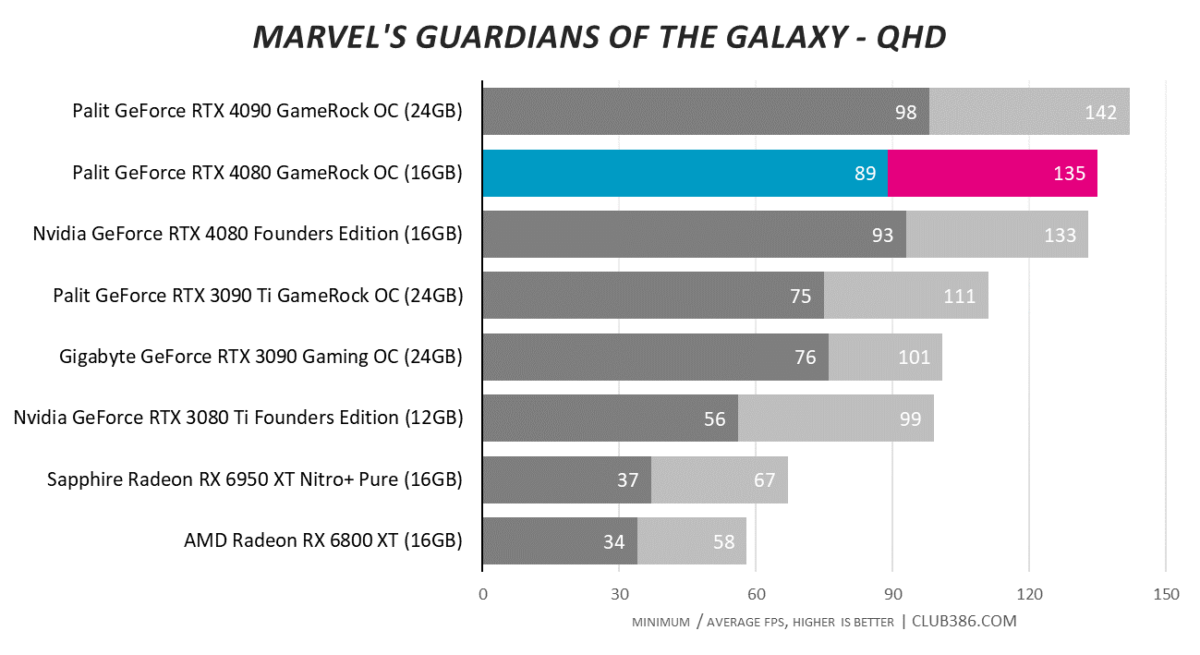
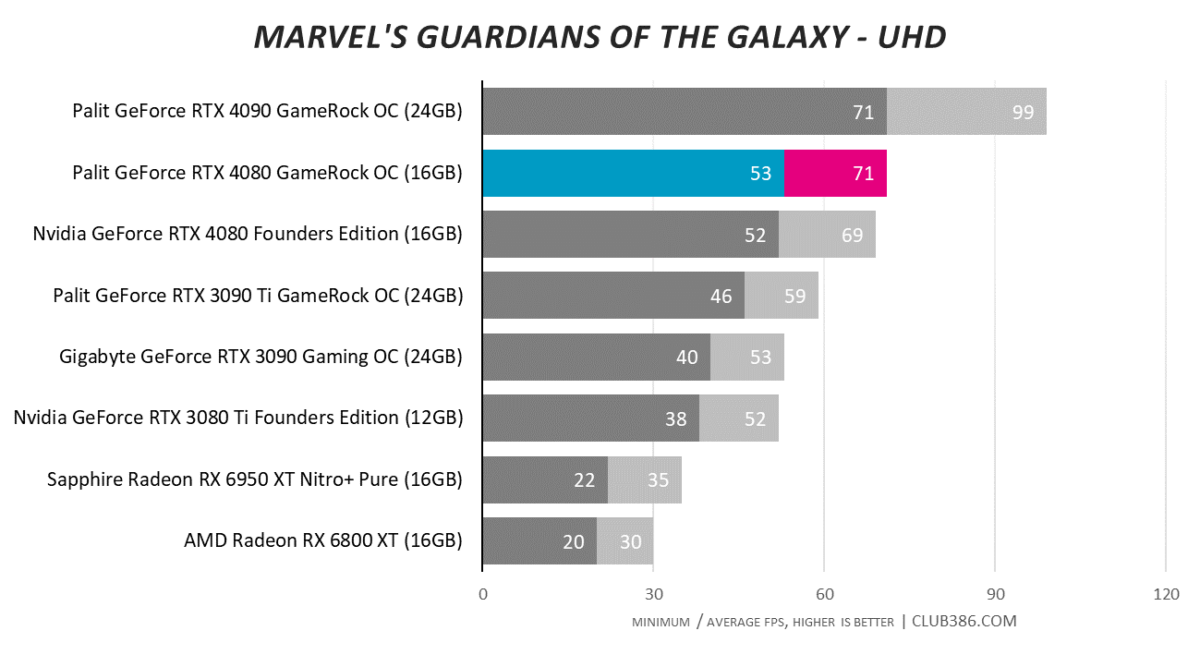
4K60 in Marvel’s Guardians of the Galaxy with ultra raytracing settings ought to be the benchmark for any next-gen GPU. RTX 4080 exceeds that target. No pressure, Radeon RX 7900 XTX.
Tom Clancy’s Rainbow Six Extraction
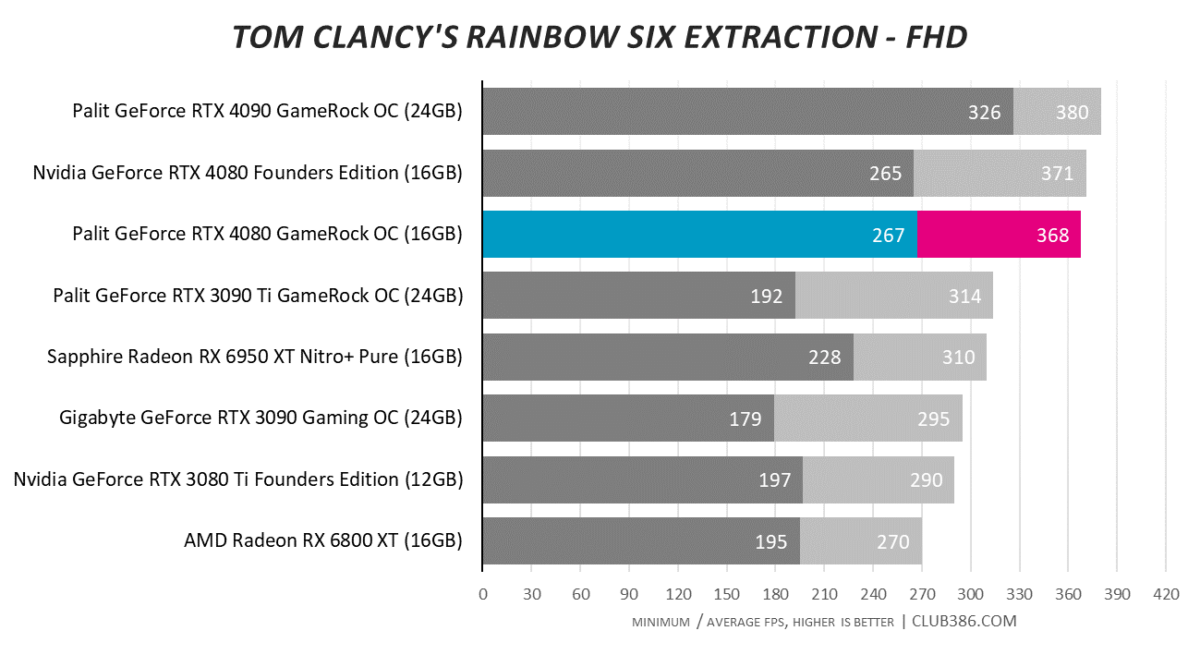
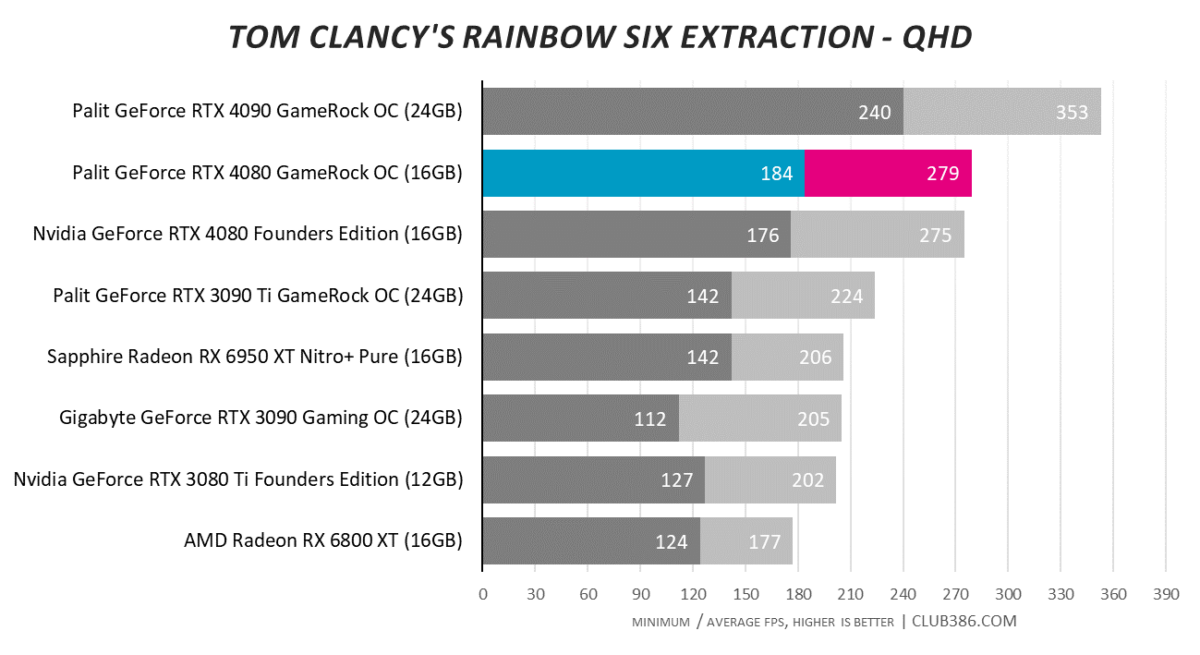
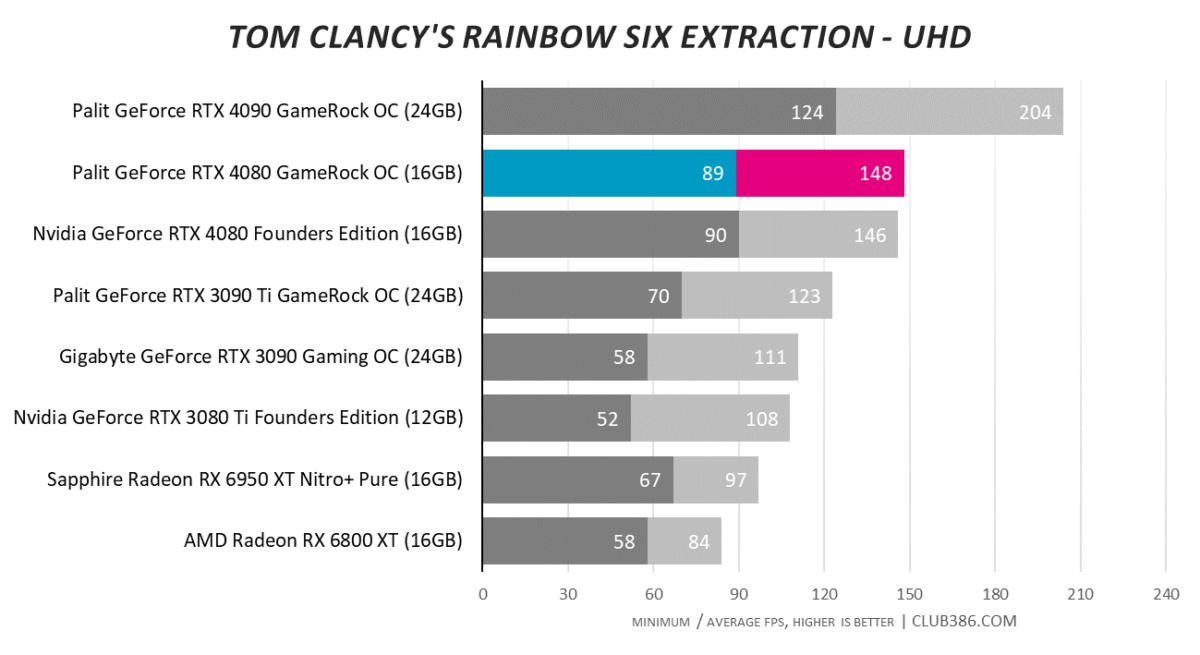
RTX 4080 tears up everything from the previous generation with ease, and RTX 4090 beats RTX 4080 by a further 38 per cent. Staggering.
Power, Temps and Noise
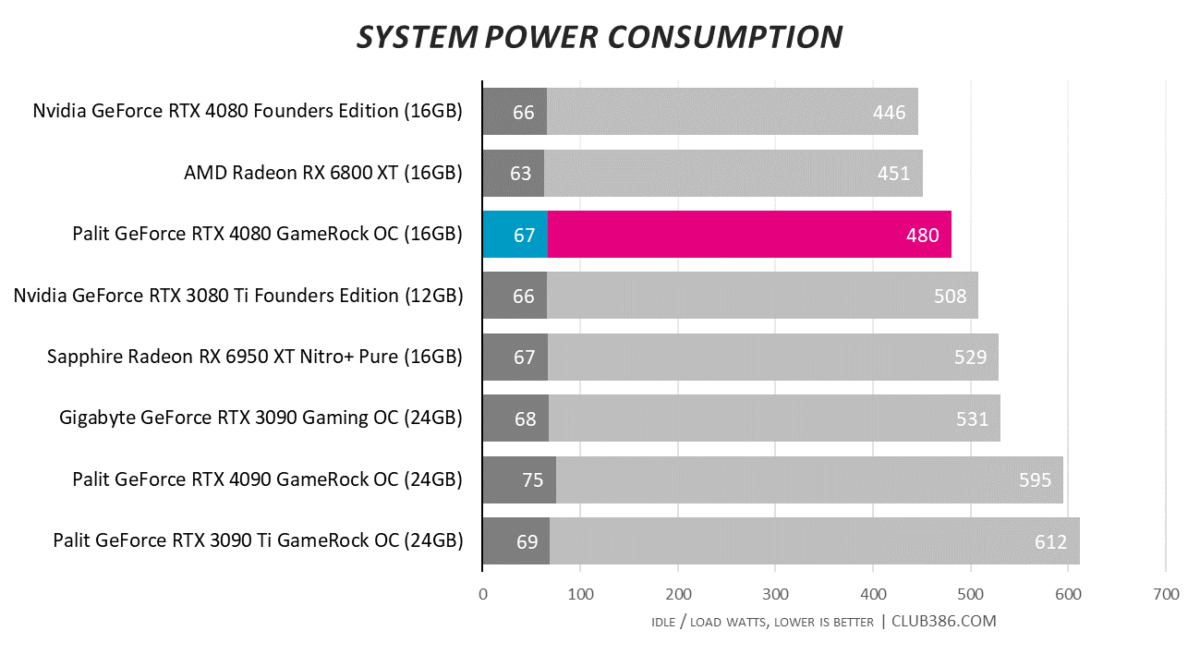
Hmmm. There had to be a snag, didn’t there? GameRock OC’s modest factory overclock increases system-wide, in-game power consumption by almost eight per cent over the Founders Edition.
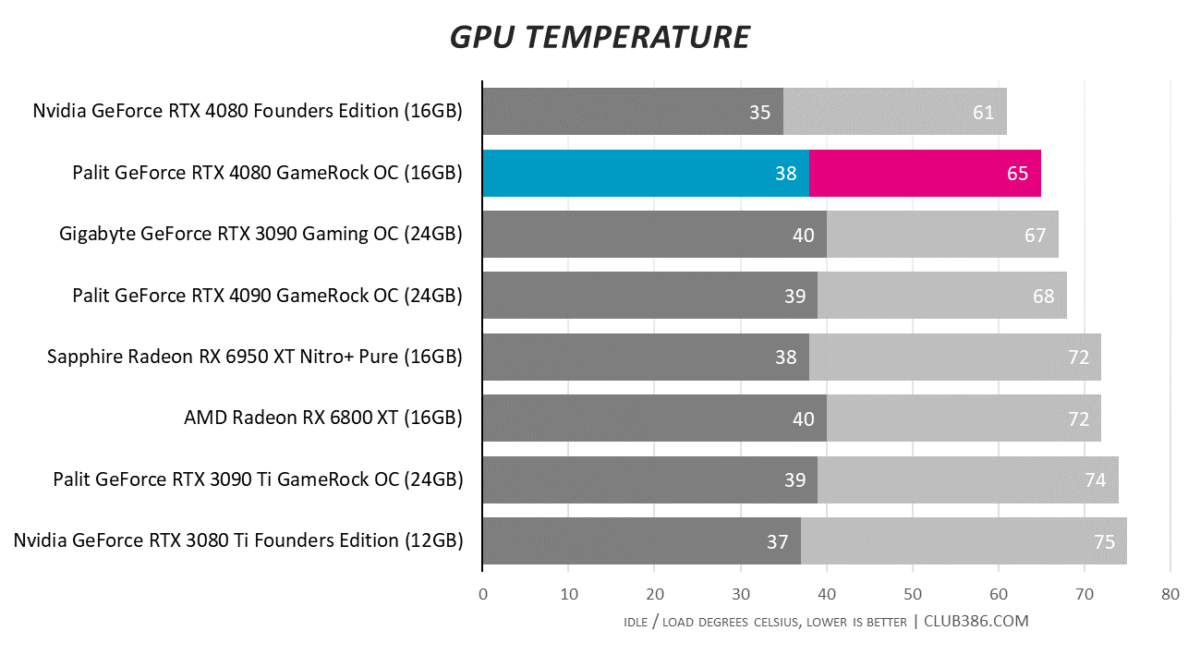
Nvidia’s in-house design remains the card to beat in terms of cooling performance, yet 65°C is an admirable result. No issues here.
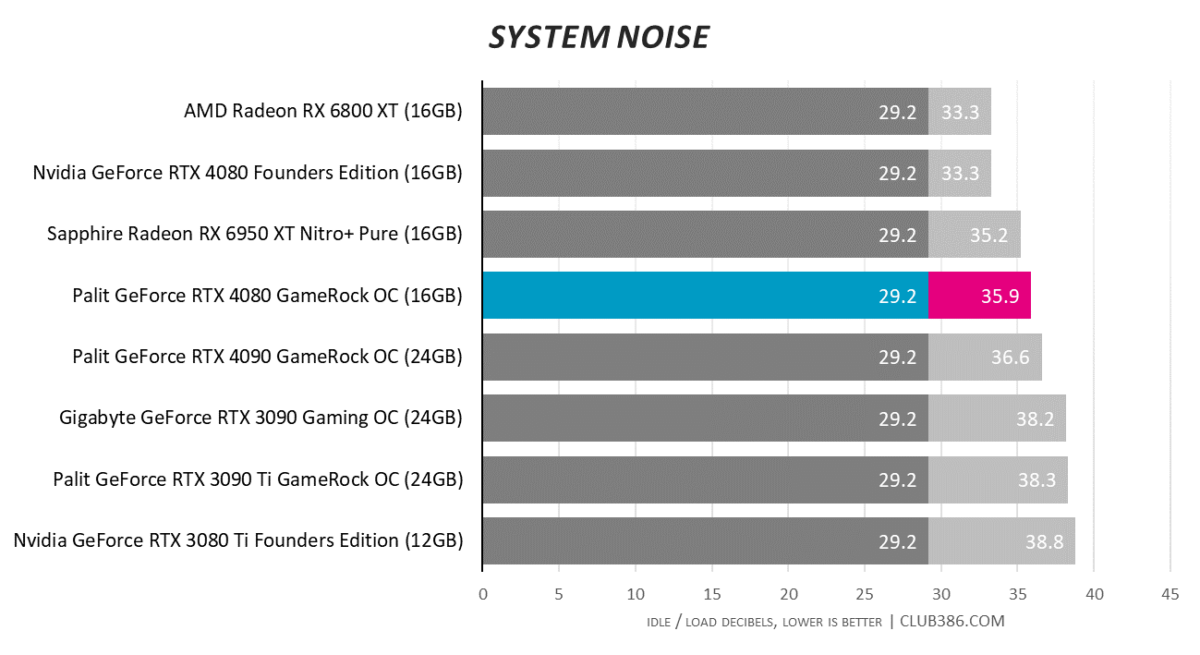
GameRock OC runs quiet, too. The fans aren’t quite as well tuned as the eerily hushed Founders Edition, yet save for the glow of the epic RGB lighting, you won’t be distracted by the graphics card.
Overclocking
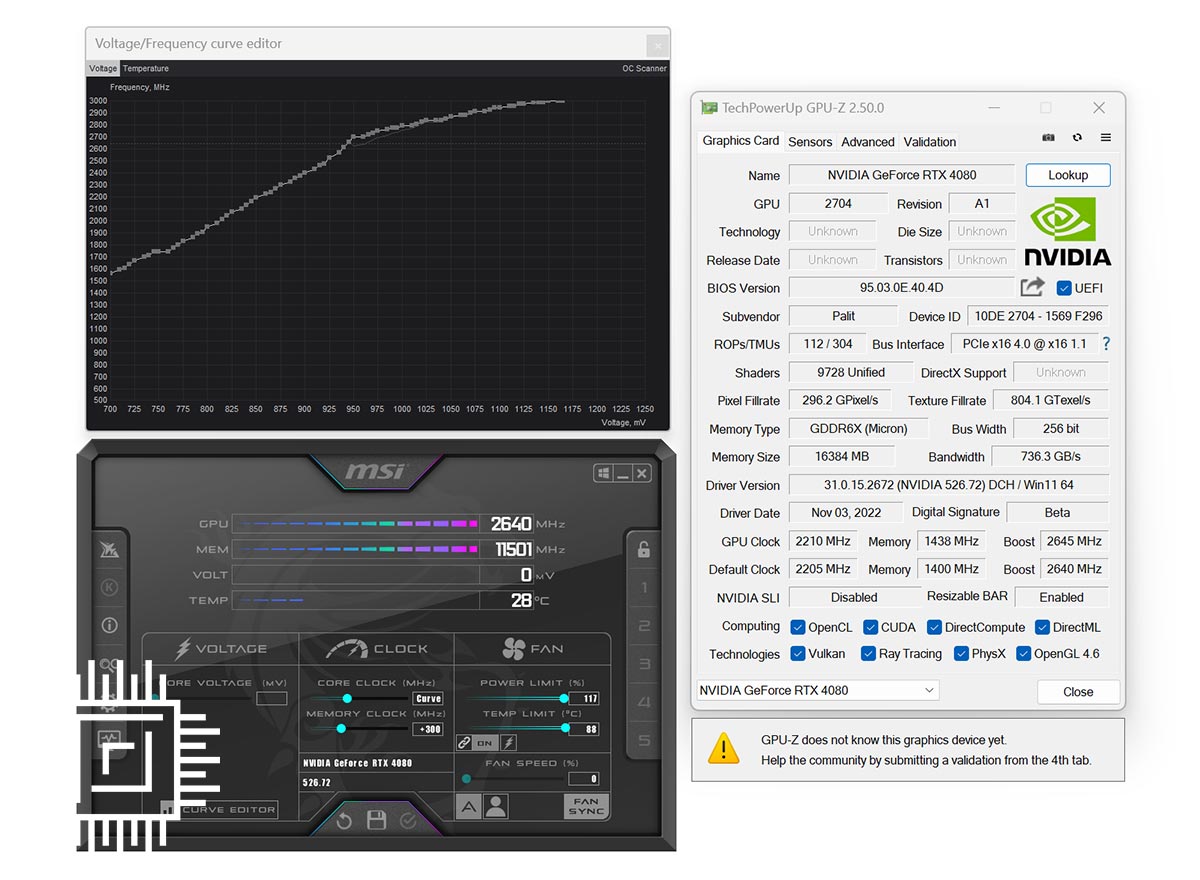
RTX 4080 doesn’t have a great deal of headroom at stock voltages, and factory overclocked cards are already running close to the ceiling. It’s easy to push memory to over 23Gbps, but in truth, you’re not going to see much more performance when using automated scanners.
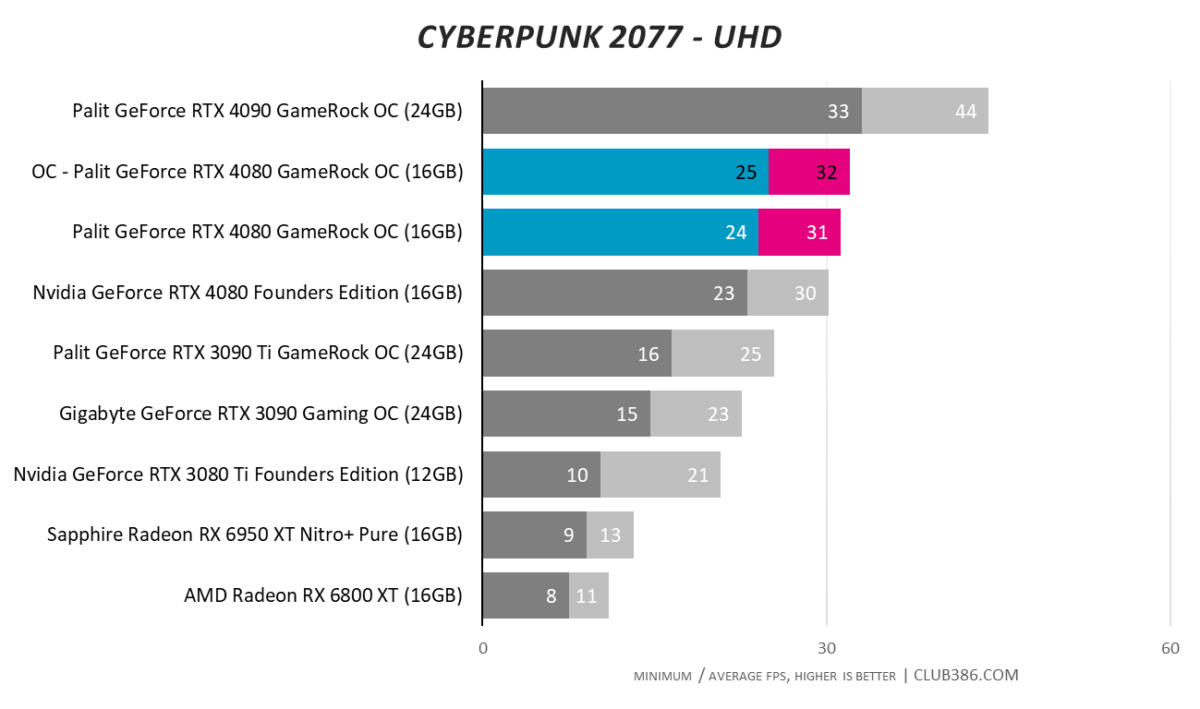
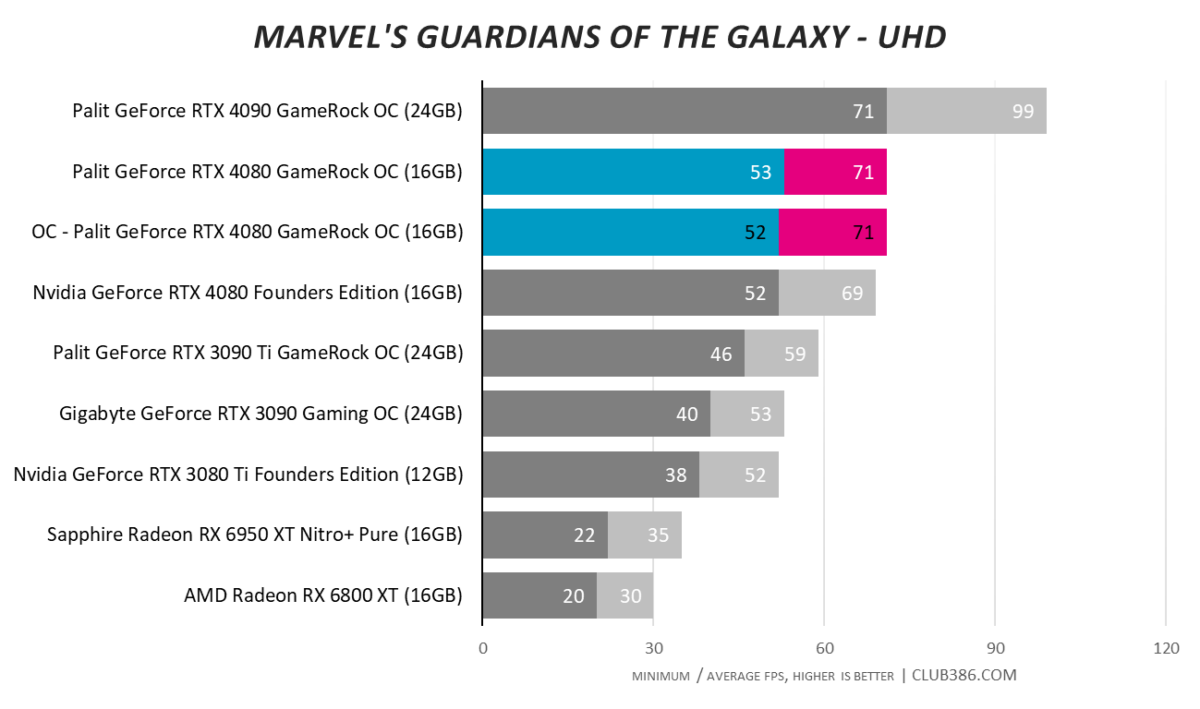
Basic overclocking is hardly worth the effort. DLSS, on the other hand, is well worth pursuing.
DLSS 3
Having spent the past few decades evaluating GPUs in familiar fashion, it is eye-opening to witness a sea change in how graphics performance is both delivered and appraised.
THUNDEROUS RASTERISATION AND LIGHTNING RT CORES, YET DLSS 3 IS THE STORM THAT’S BREWING
RTX 40 Series may boast thunderous rasterisation and lightning RT Cores, yet DLSS 3 is the storm that’s brewing. Rejogging the memory banks after all those benchmarks, remember developers now have the option to enable individual controls for Super Resolution and/or Frame Generation. The former, as you’re no doubt aware, upscales image quality based on setting; Ultra Performance works its magic on a 1280×720 render, Performance on 1920×1080, Balanced works at 2227×1253, and Quality upscales from 2560×1440.
On top of that, Frame Generation inserts a synthesised frame between two rendered, resulting in multiple configuration options. Want the absolute maximum framerate? Switch Super Resolution to Ultra Performance and Frame Generation On, leading to a 720p upscale from which whole frames are also synthesised.
Want to avoid any upscaling but willing to live with frames generated from full-resolution renders? Then turn Super Resolution off and Frame Generation On. Note that enabling the latter automatically invokes Reflex; the latency-reducing tech is mandatory, once again reaffirming the fact that additional processing risks performance in other areas.
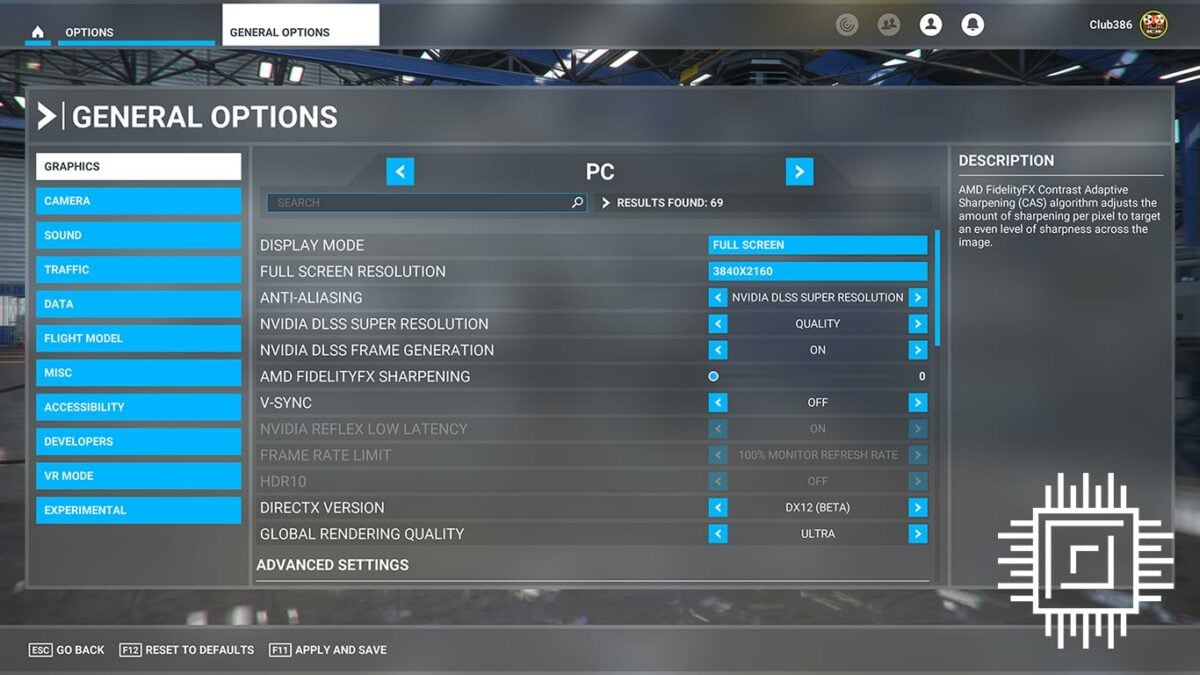
Reviewers have been granted access to pre-release versions of select titles incorporating DLSS 3 tech. Initial impressions are that developers are still getting to grips with implementation. Certain games require settings to be enabled in a particular sequence for DLSS 3 to properly enable, while others simply crash when alt-tabbing back to desktop. There are other limitations, too. DLSS 3 is not currently compatible with V-Sync (FreeSync and G-Sync are fine) and Frame Generation only works with DX12.
Point is, while Nvidia reckons uptake is strong – some 35 DLSS 3 games have already been announced – these are early days, and some implementations will work better than others. Microsoft Flight Simulator is one of the first to officially support DLSS 3 as part of Sim Update XI (SU11, pictured above), and the results are dramatic to say the least.
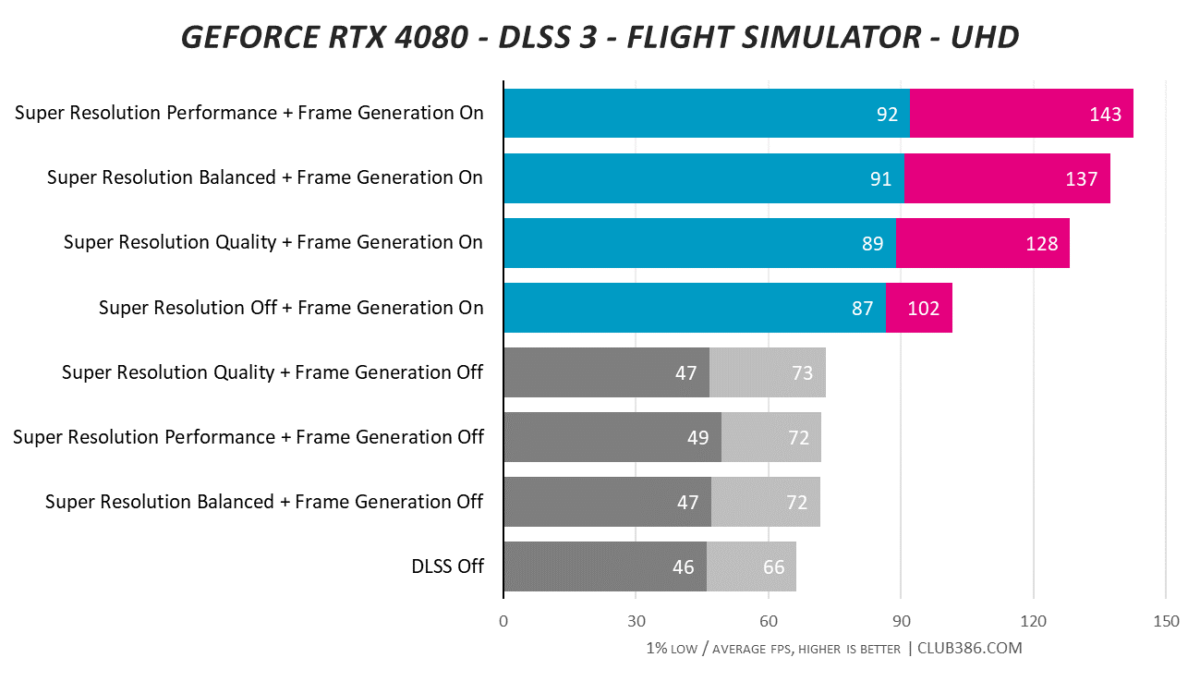
Performance is benchmarked at a 4K UHD resolution with Ultra rendering quality. With DLSS disabled entirely, RTX 4080 is able to return an average of 66 frames per second in the Sydney Famous Landing Challenge. The game’s tendency to be CPU bound is reflected by small framerate boosts with Super Resolution (DLSS 2) set to either quality, balanced or performance. There’s little extra mileage to be had.
Frame Generation (DLSS 3) has a far more profound impact. Turning it on boosts performance by a whopping 55 per cent, climbing to 94 per cent when Super Resolution is added to the mix at maximum quality.
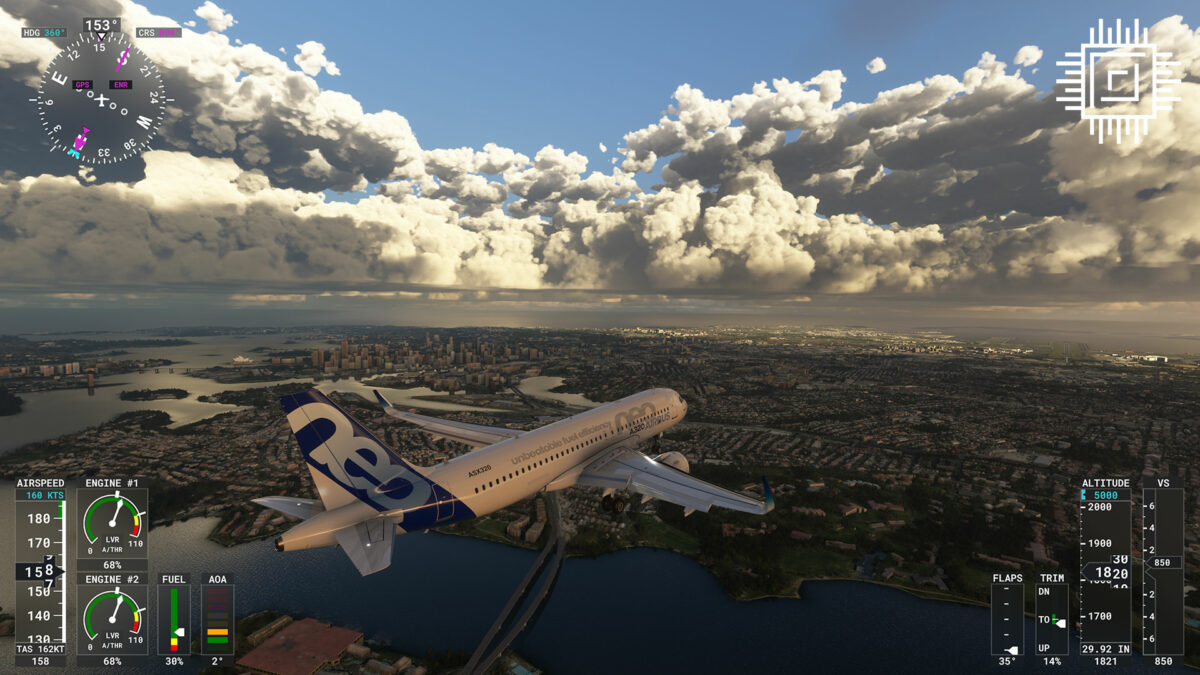
Flight Simulator is an excellent example of where Frame Generation holds merit. This is a tech unlikely to be widely used by competitive gamers who rely on maximum accuracy, but in the right scenario, the framerate gains are simply too large to ignore. With the right monitor, the difference between 4K60 and 4K120 can be profound, and when done well there’s little detriment to image quality.
That isn’t to say it’s perfect – we did notice occasional flickering of elements in the cockpit – but you really have to look for artifacts to know they’re there. Implementation is impressive, even at this early stage, and Nvidia does well to keep latency in check through Reflex. With DLSS disabled entirely, in-game Flight Simulator latency is recorded as 54.2ms. This rises to 64.5ms with Frame Generation enabled, and then drops back down to 54.9ms with Frame Generation and Super Resolution at maximum quality.
It is too soon to deem DLSS 3 a must-have feature, yet make no mistake, it is an important feather in the 40 Series’ cap and one that rivals will soon attempt to replicate. Next-generation AMD Radeon will employ Fluid Motion Frames in an effort to double 4K framerate, but when exactly the tech will be available, and how well it performs, remains unknown.
Conclusion
Following the blockbuster performance of GeForce RTX 4090, Nvidia extends its assault on the high-end with GeForce RTX 4080. Starting at £1,269, the new addition cements RTX 40 Series’ positioning as the preserve of deep-pocketed enthusiasts, and even when a third GPU reappears, don’t expect much change from a thousand pounds for an alleged RTX 4070 Ti.
Founders Editions lead the charge, and with the in-house design evolving dramatically in terms of size and performance, add-in-board partners are granted little room to manoeuvre. Producing cooler and quieter cards is no longer a given, and the focus instead shifts to factory-overclocked variants that stand out through unique aesthetics.
GameRock OC is one of the better interpretations of that brief. Out-the-box speeds are both fast and stable, and if you’re speccing a rig to turn heads, few graphics cards are as eye-catching as the kaleidoscopic, RGB-infused Palit. The obvious issue is there’s no scope to undercut Nvidia on price, and partners face the unenviable prospect of charging more for a GPU already deemed financially extravagant.
Consumers are voting with their wallets – custom RTX 4080 boards are in stock and readily available everywhere – and you have to wonder if such lofty positioning is tenable amid a broader industry downturn.
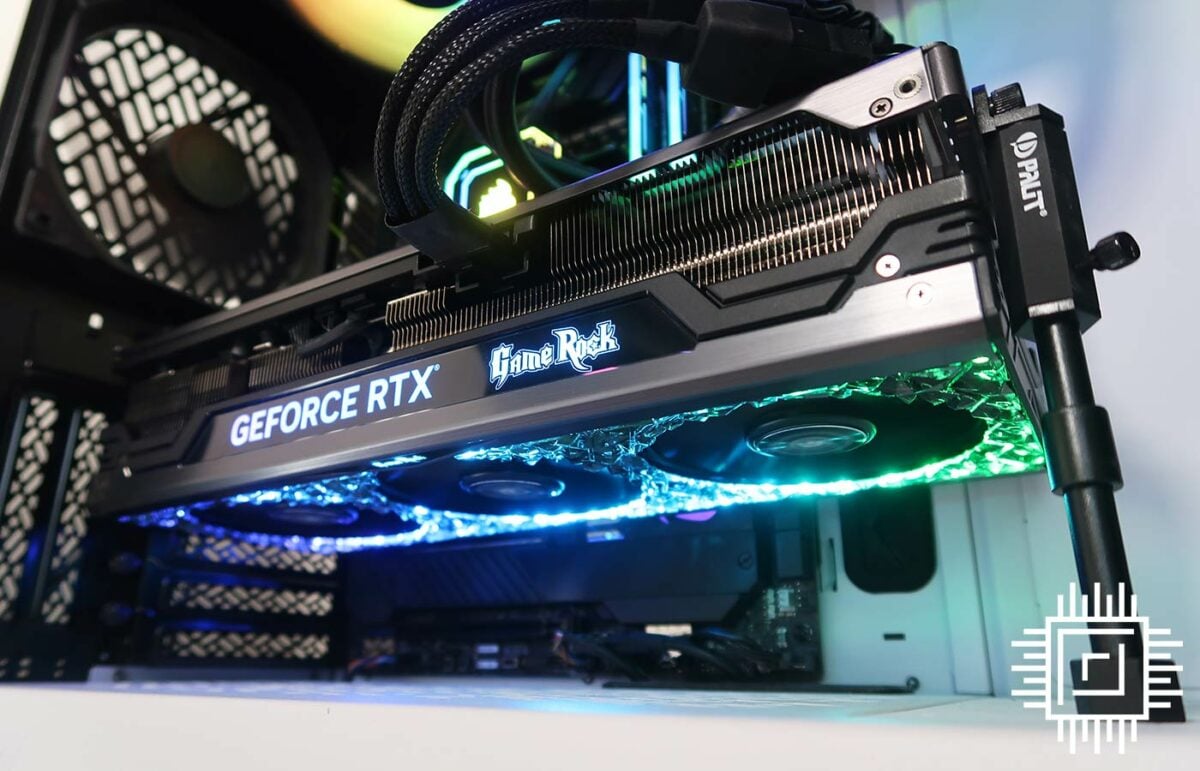
Palit GeForce RTX 4080 GameRock OC
Verdict: Eye-catching and impressively fast, Palit’s latest GameRock OC is a fine card in need of a lower price.
This article first cameout at https://www.club386.com/
